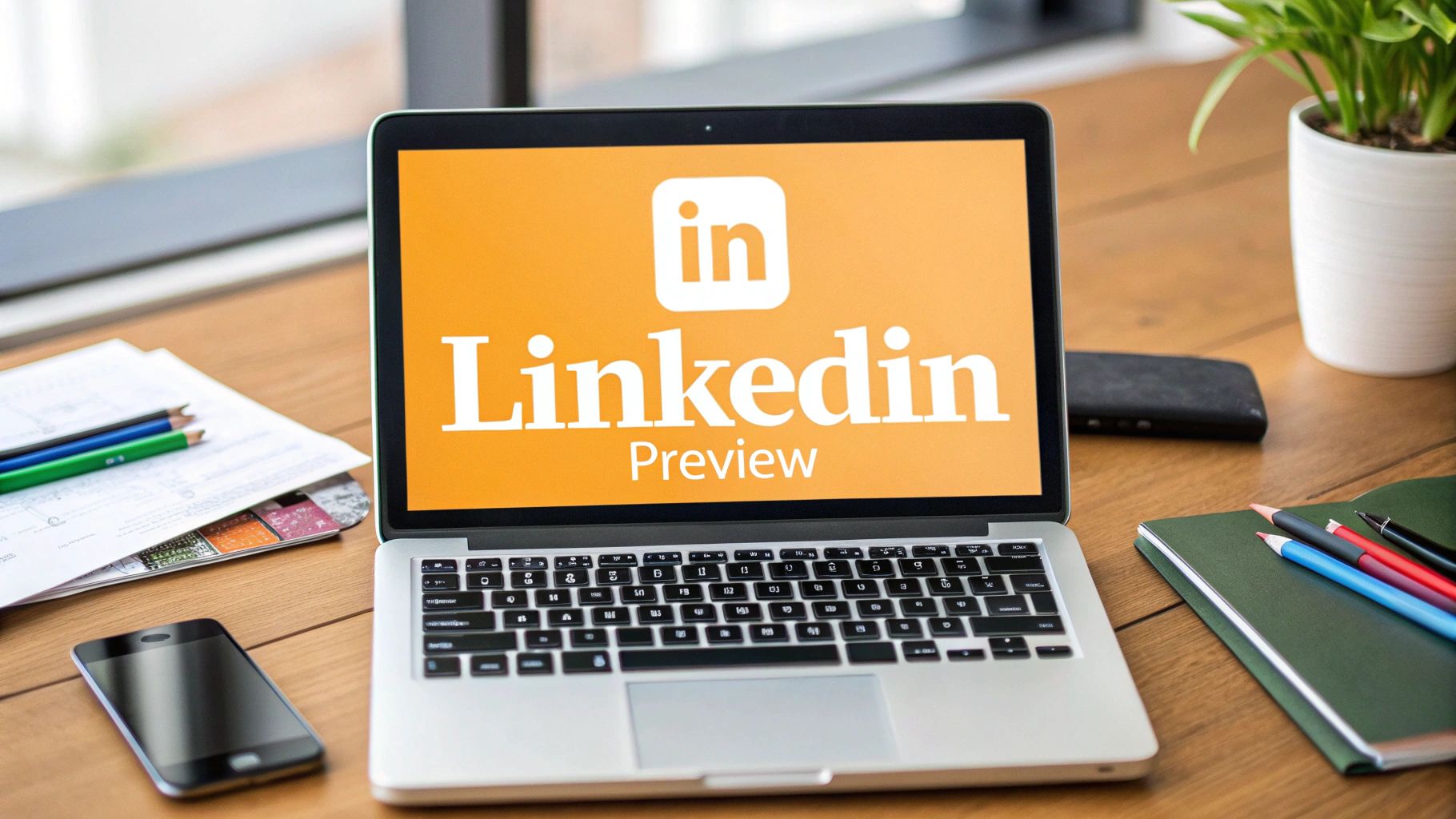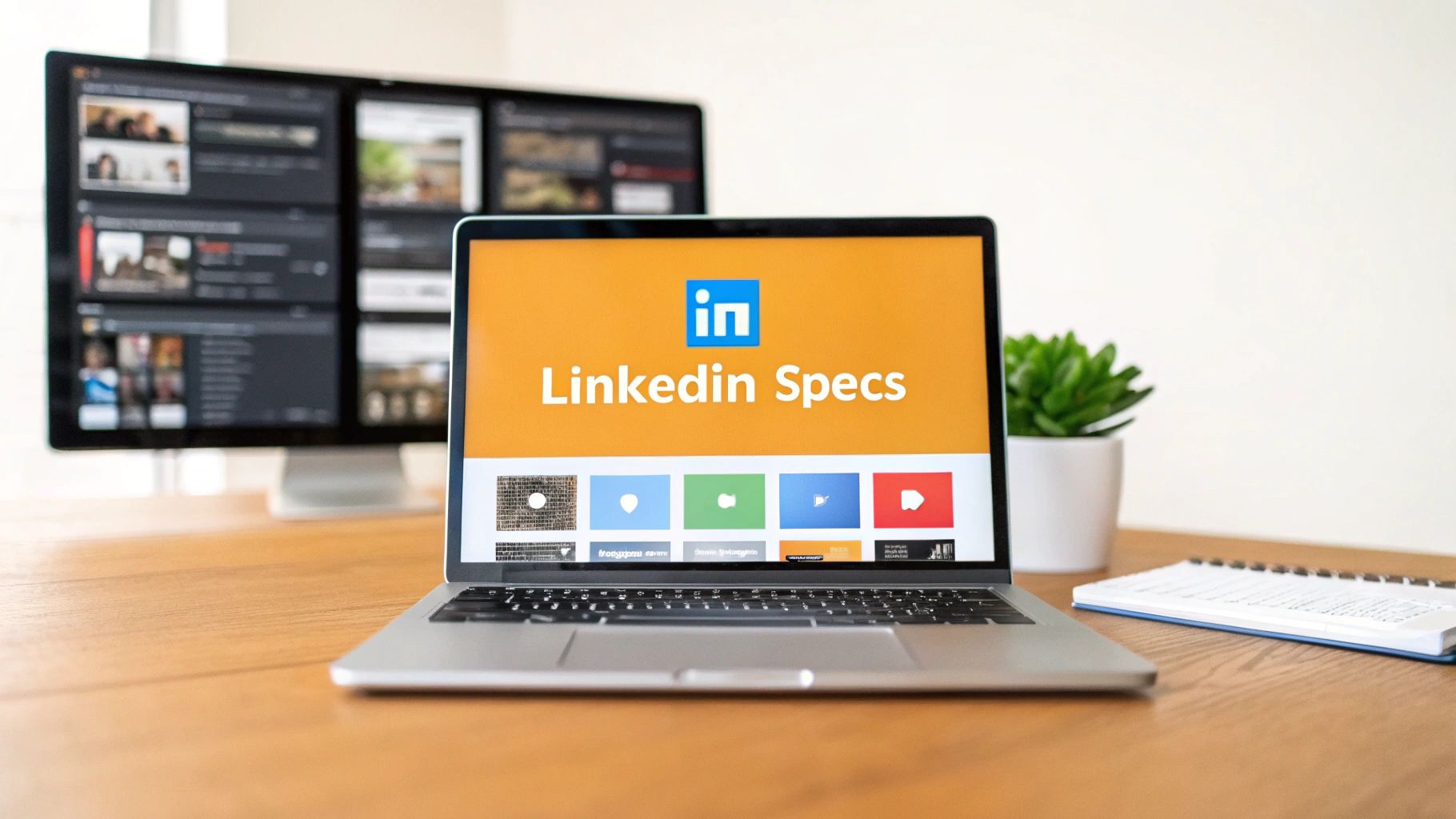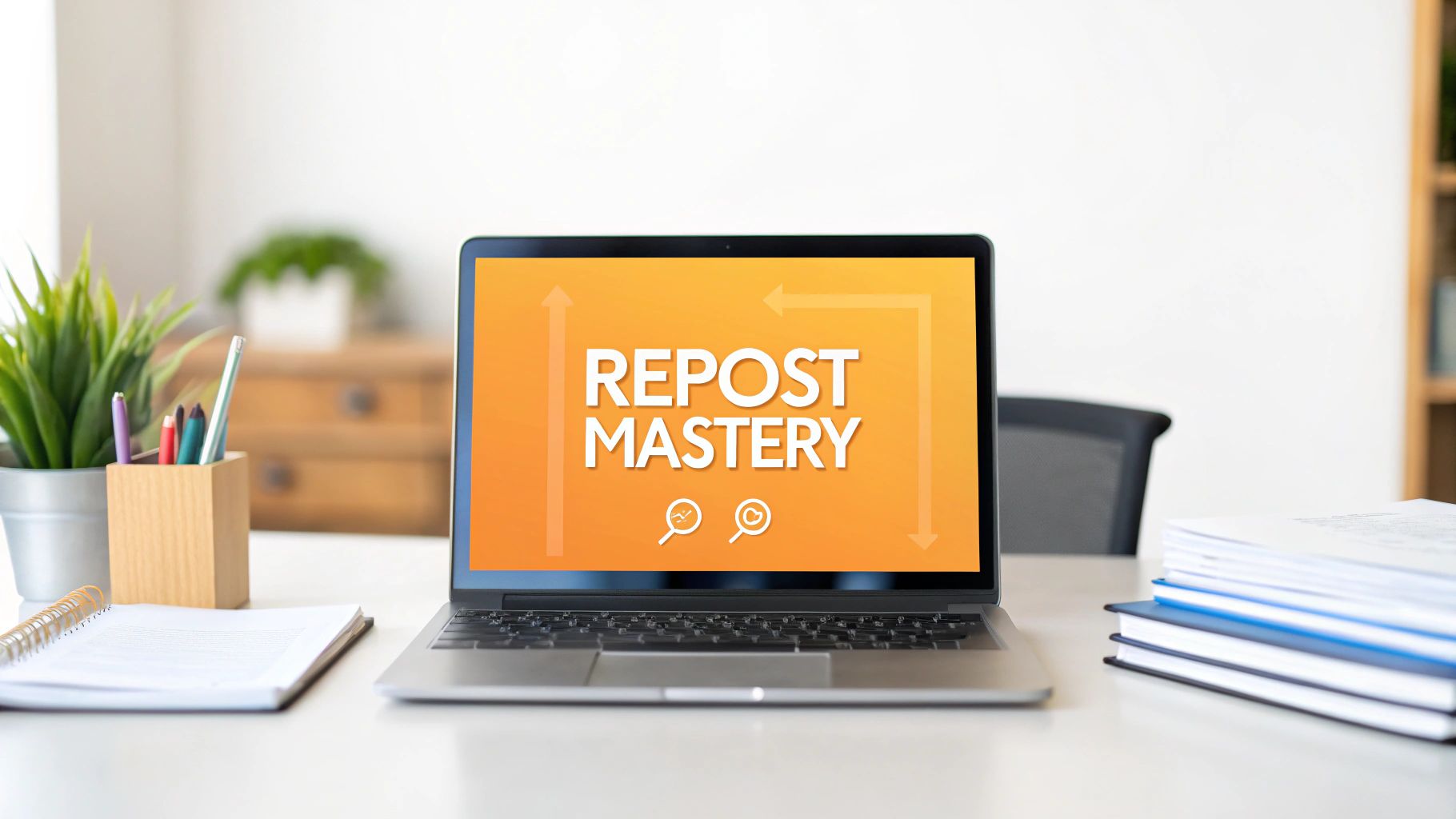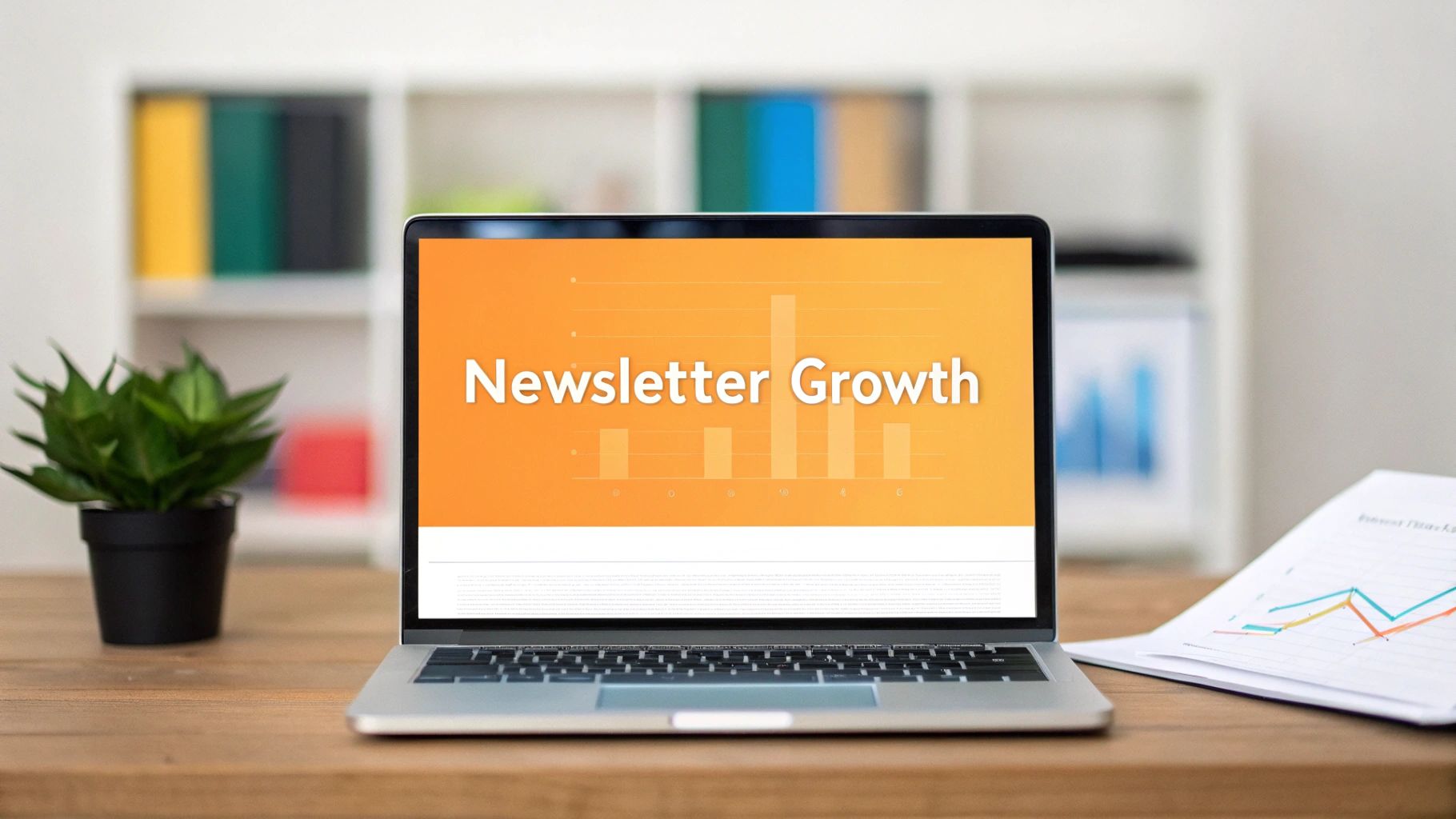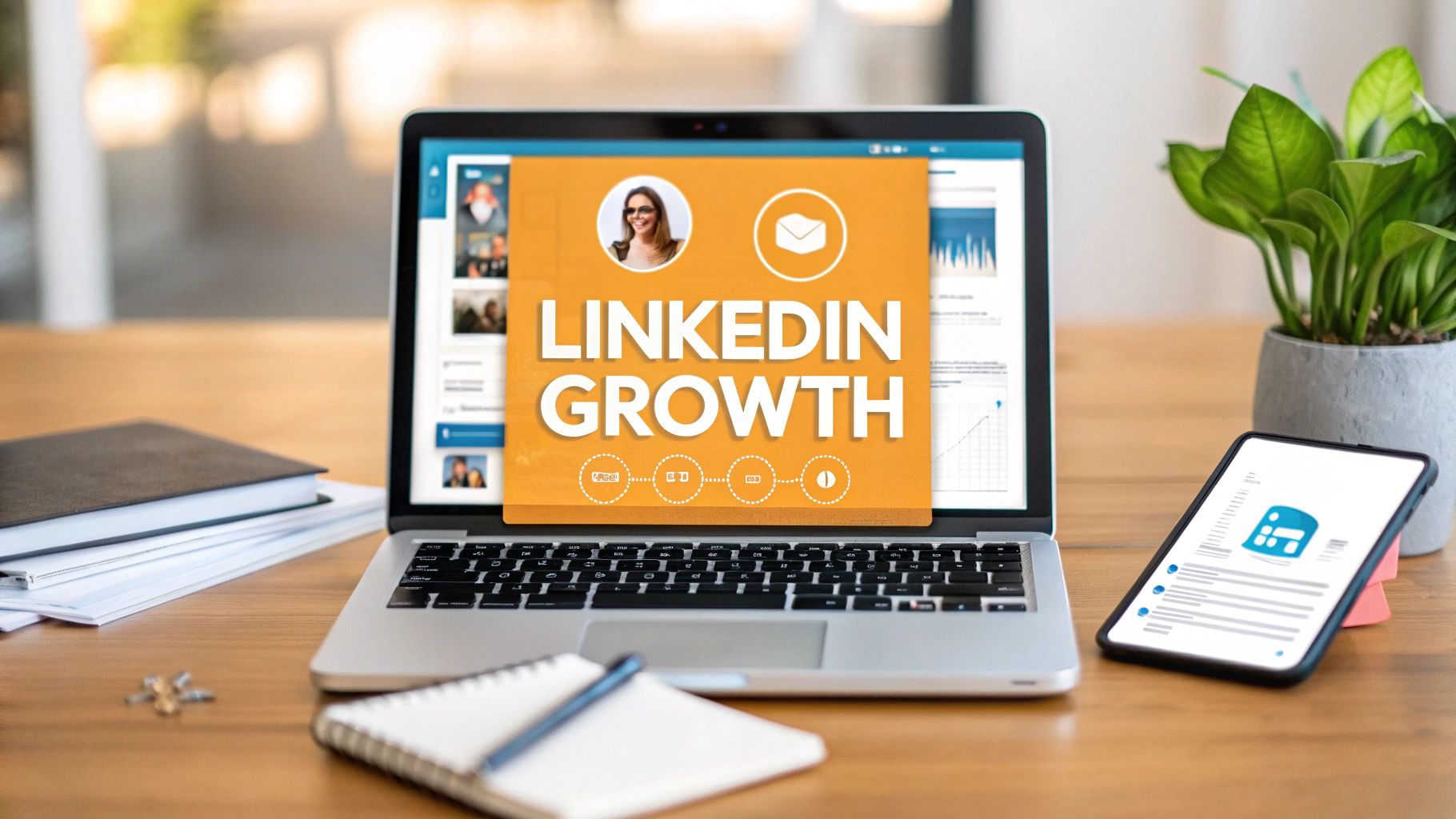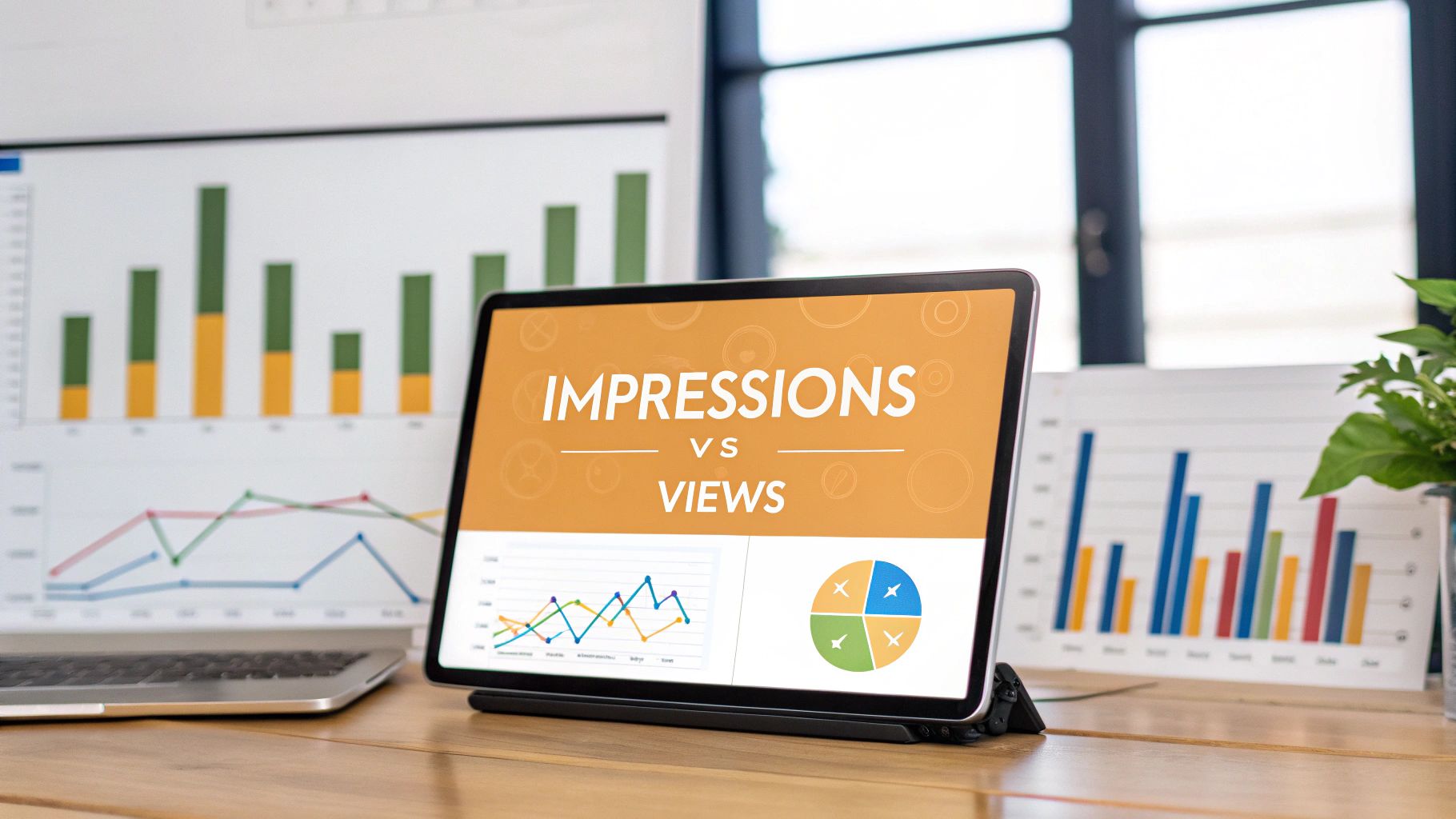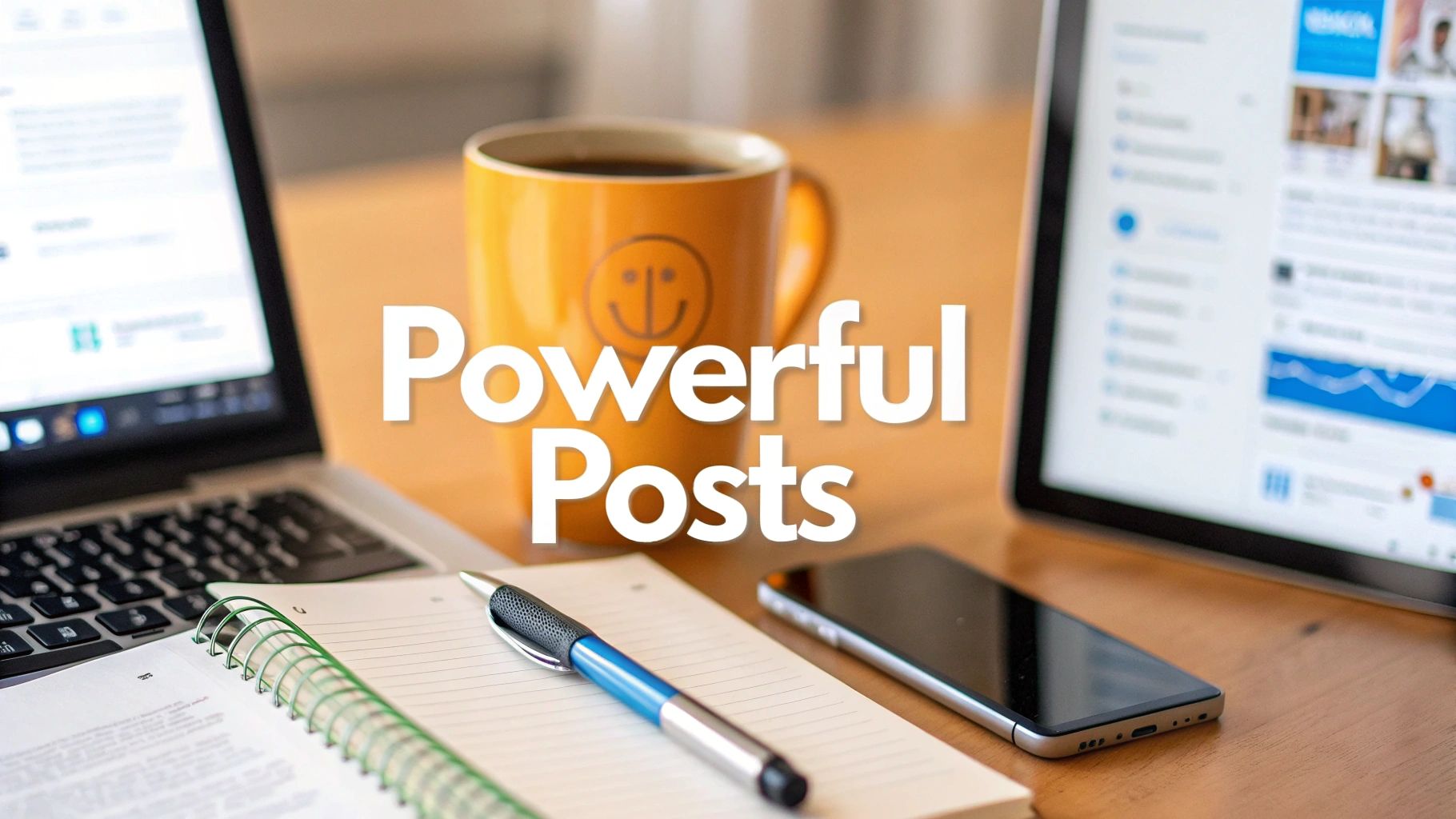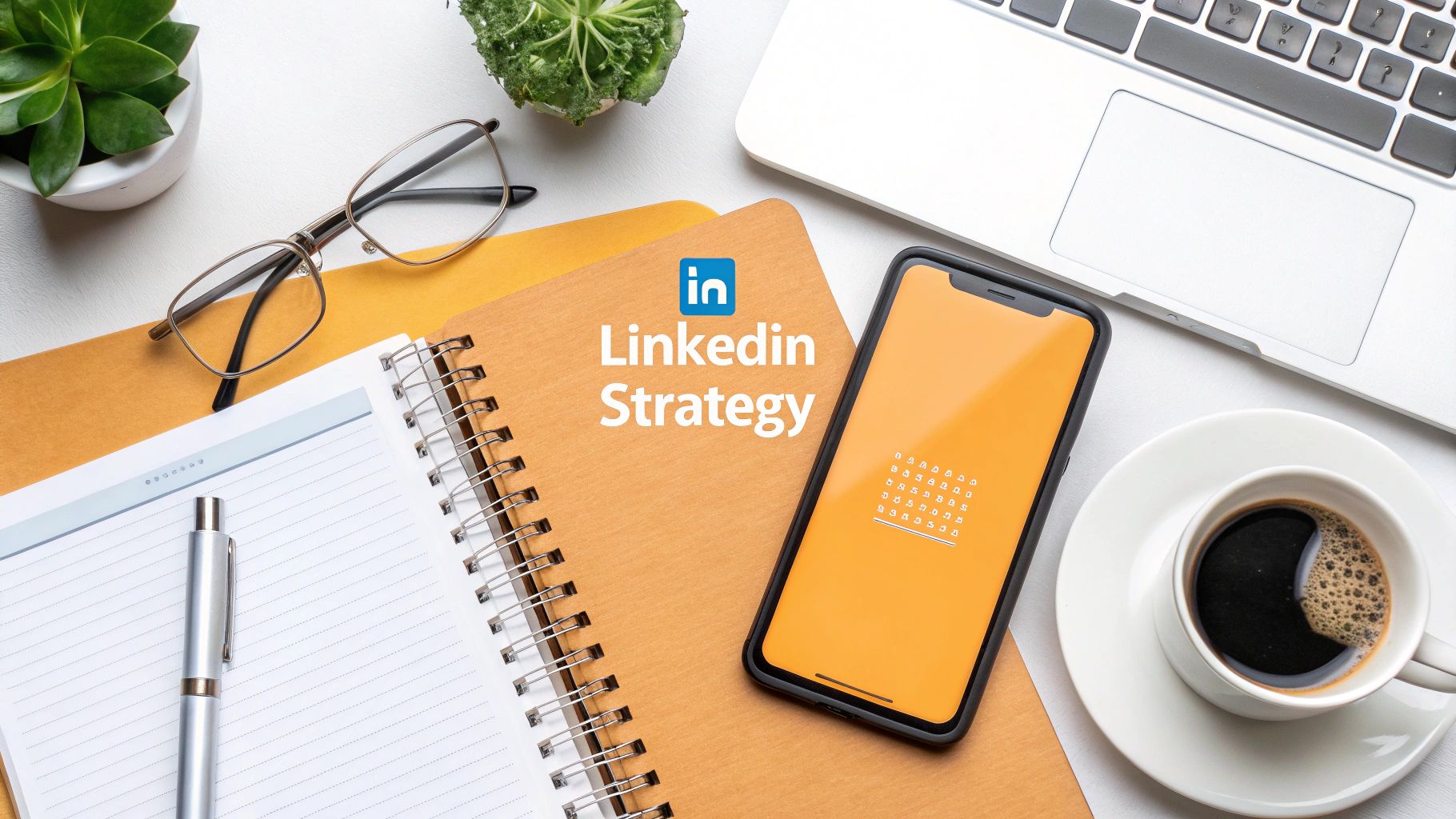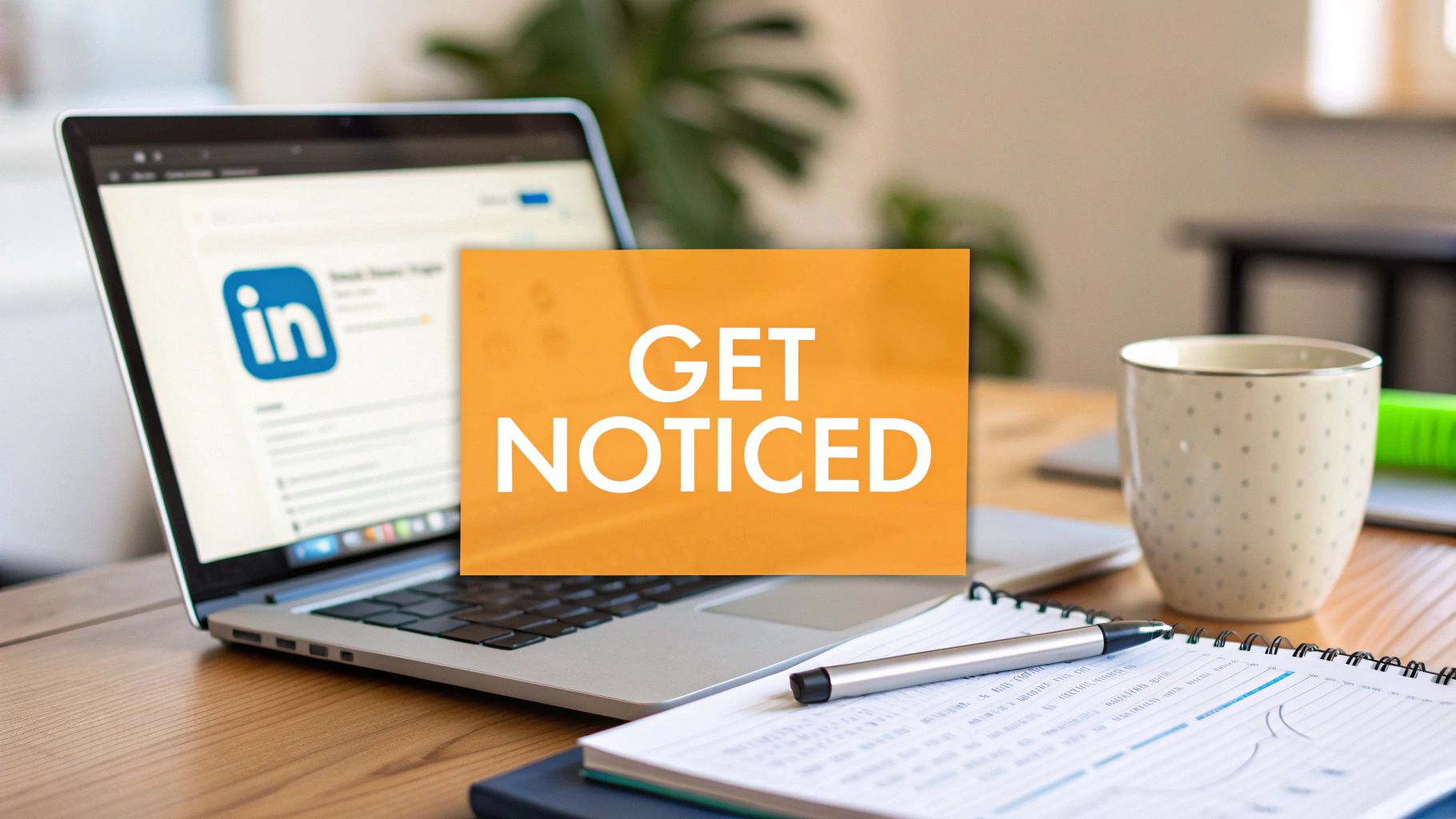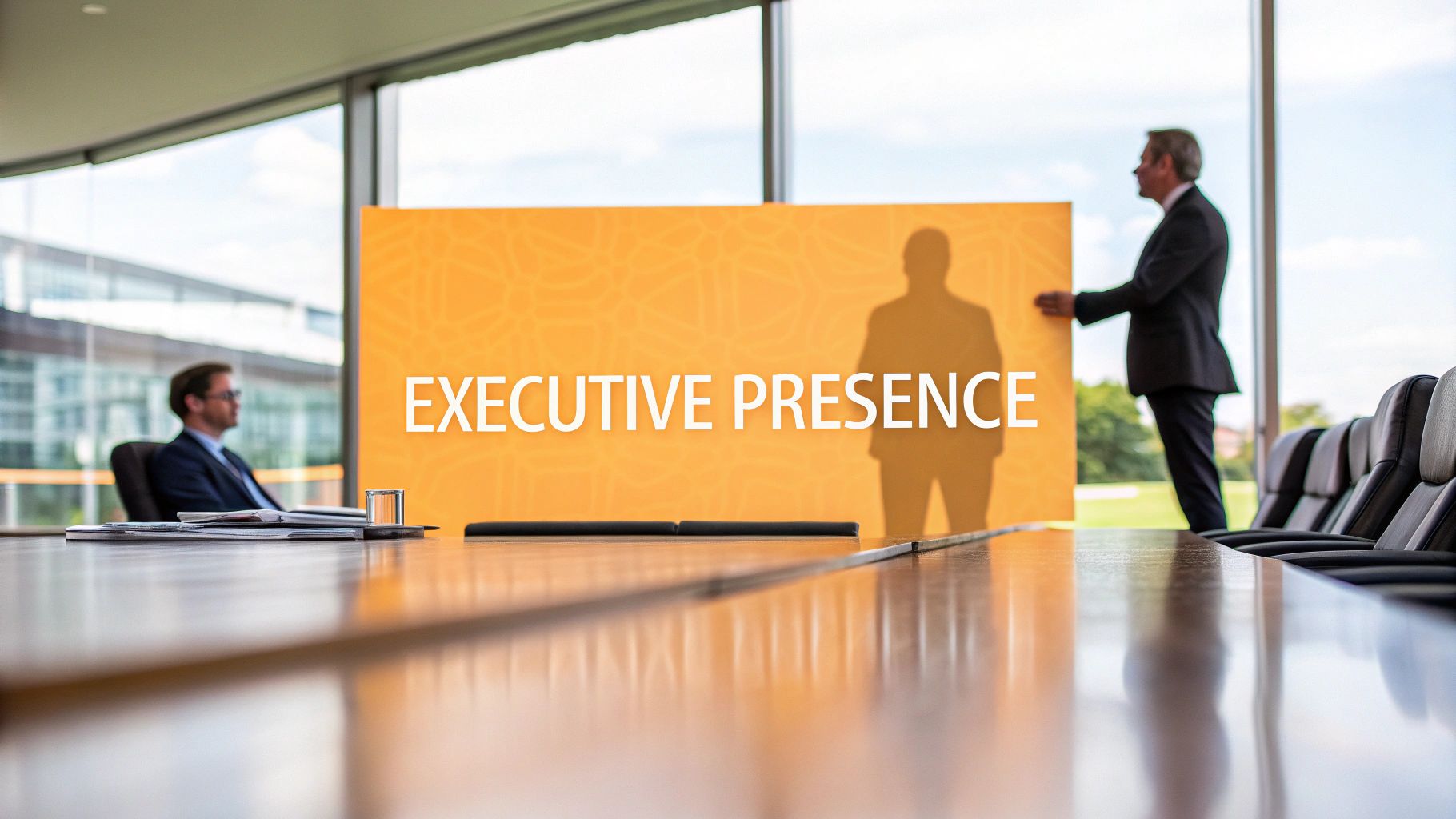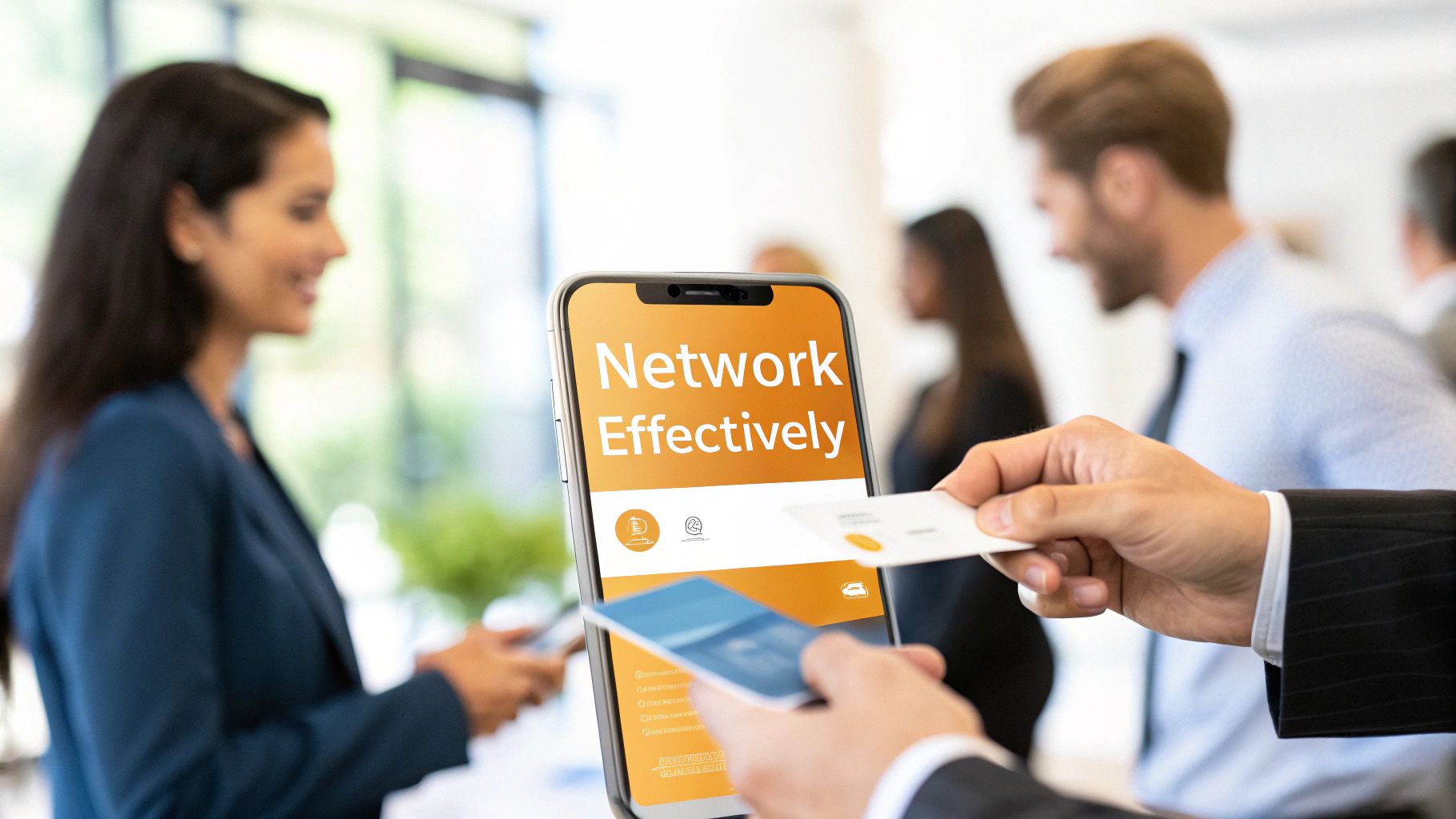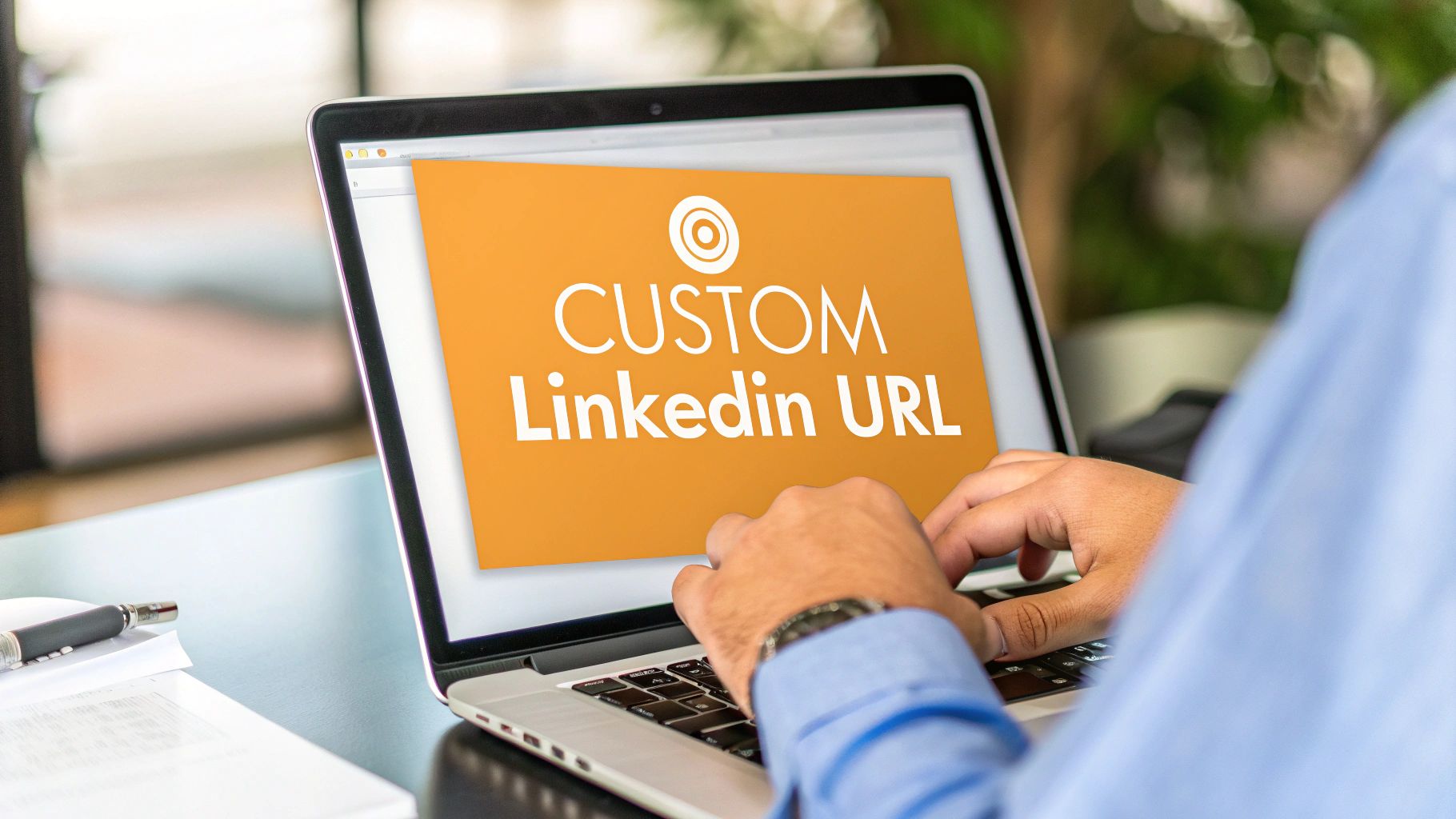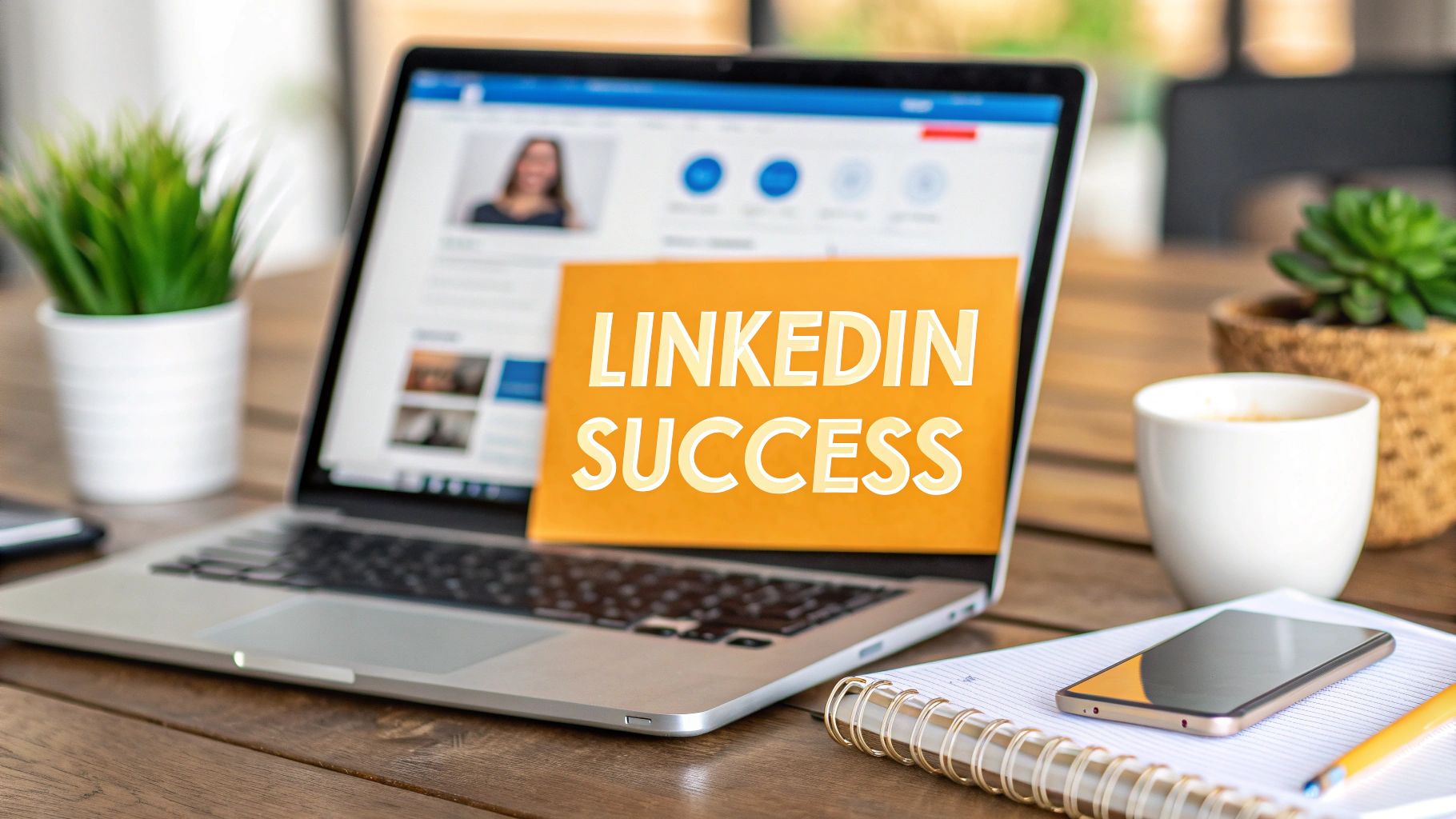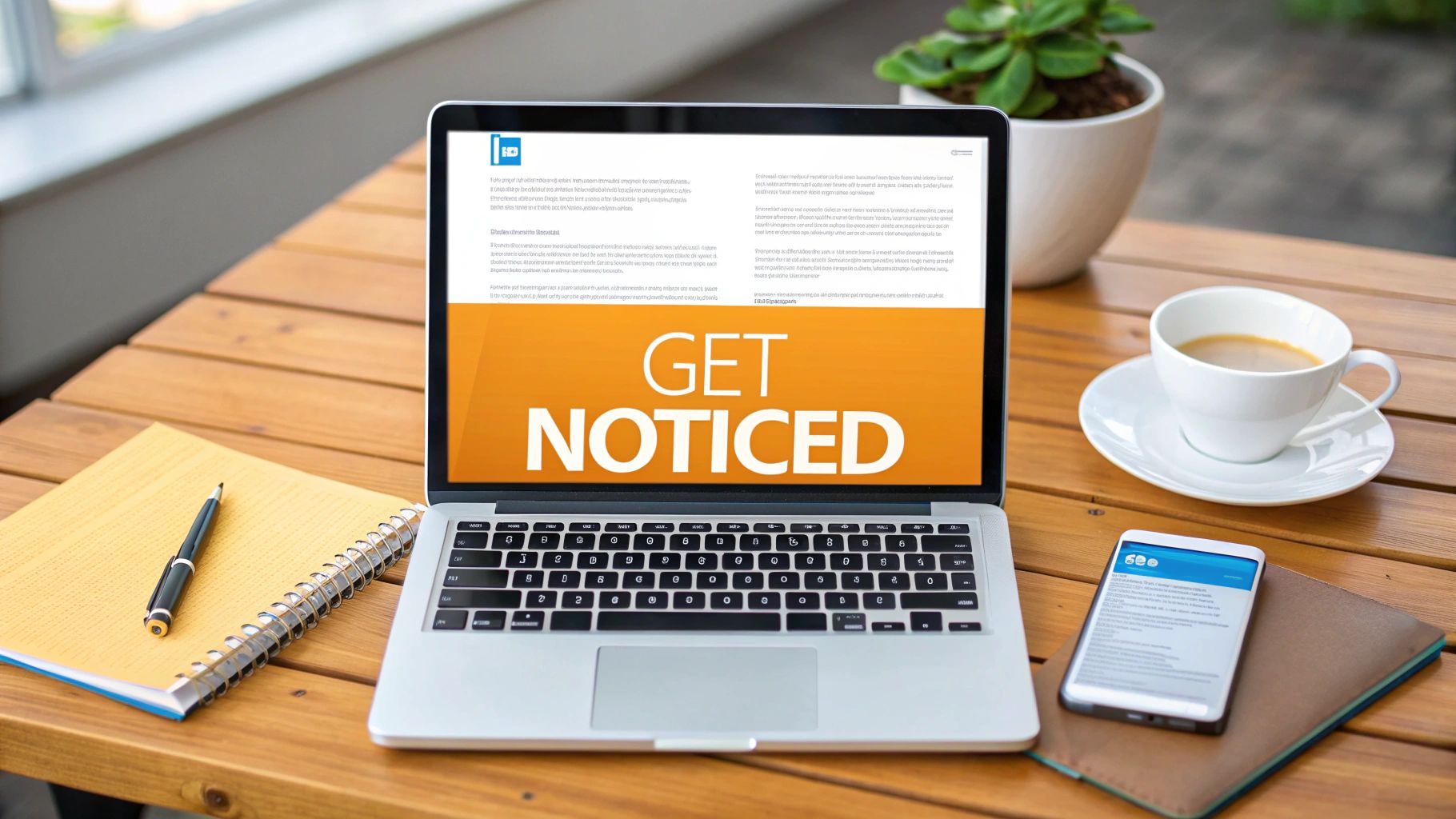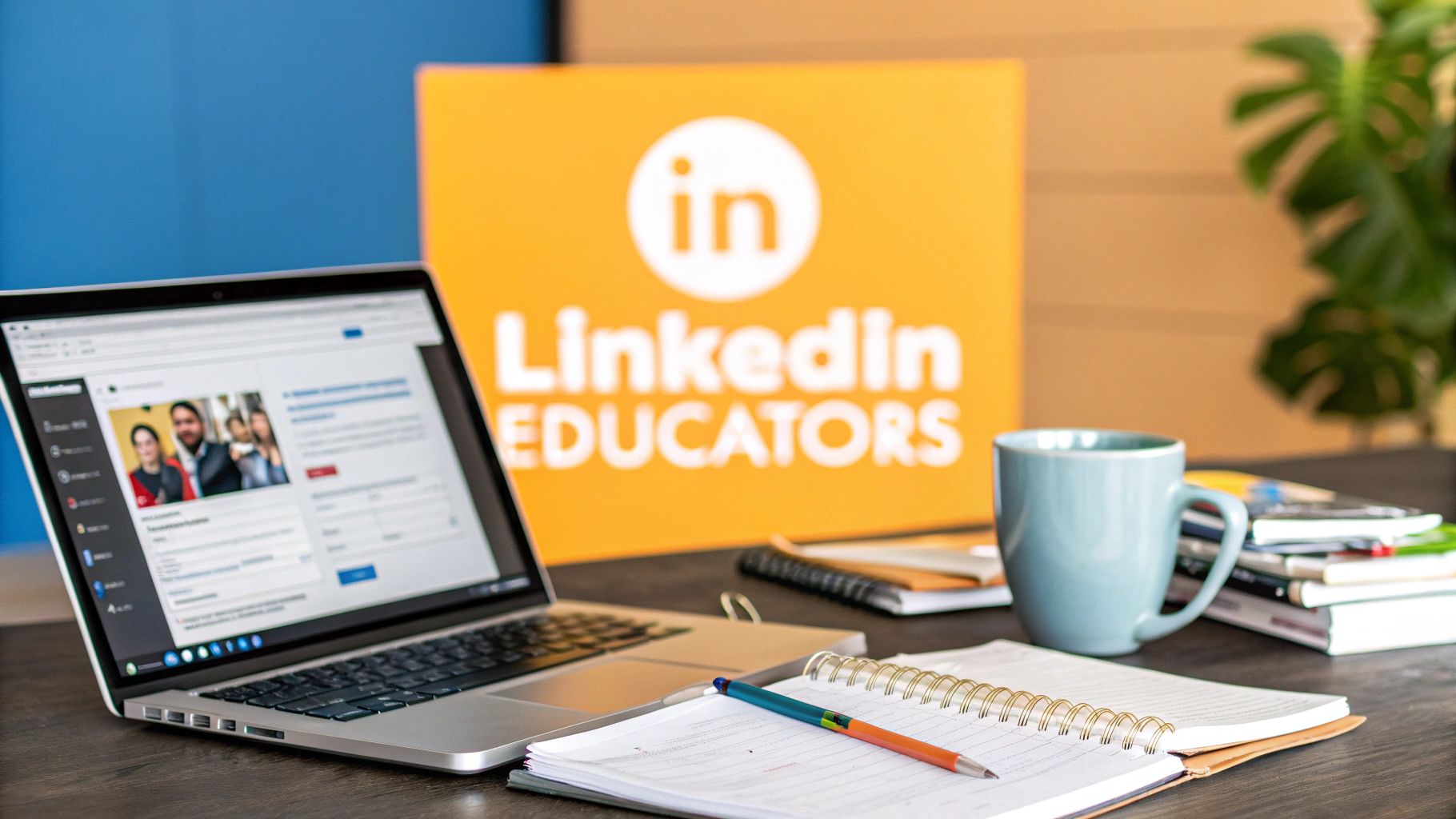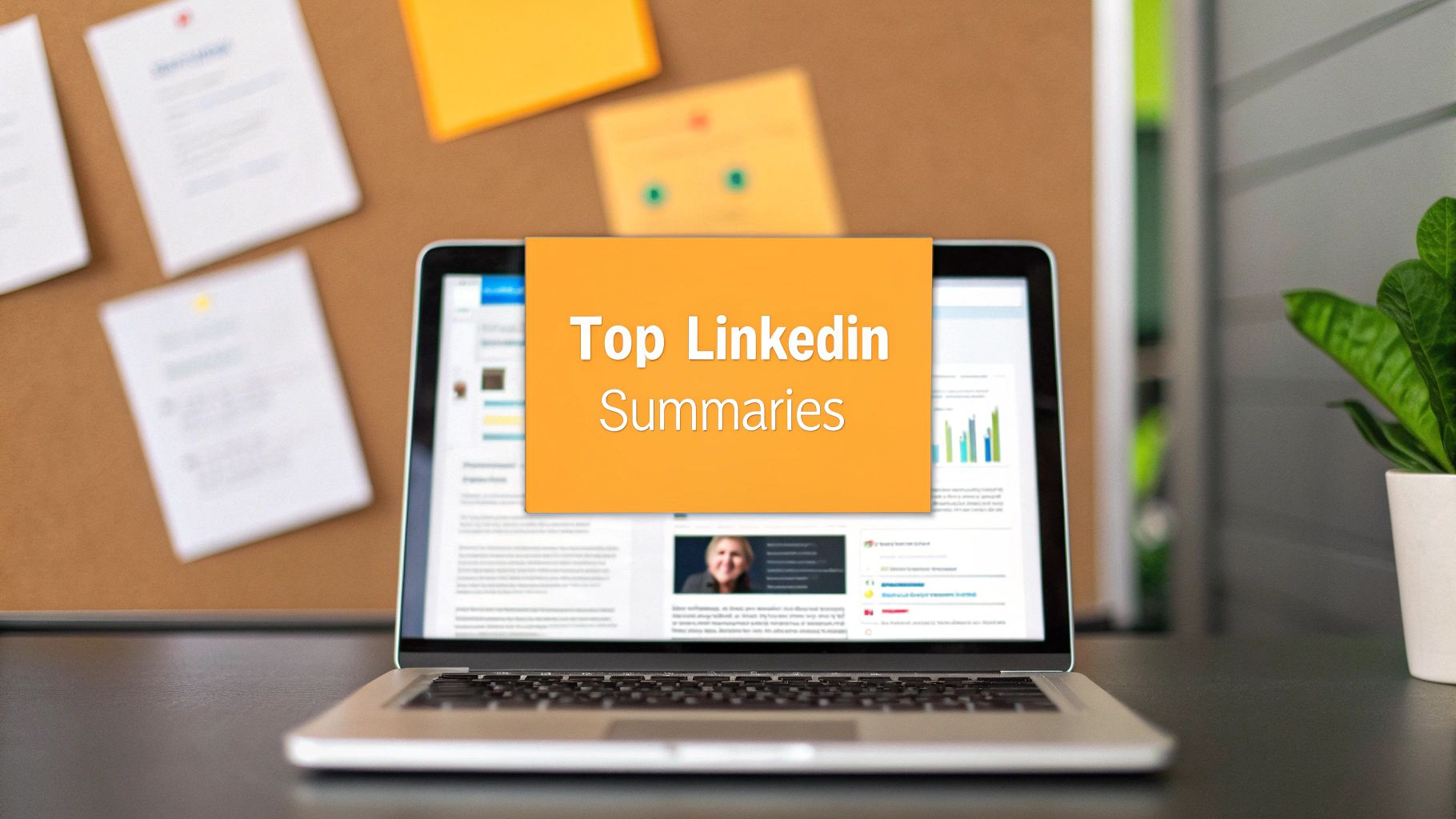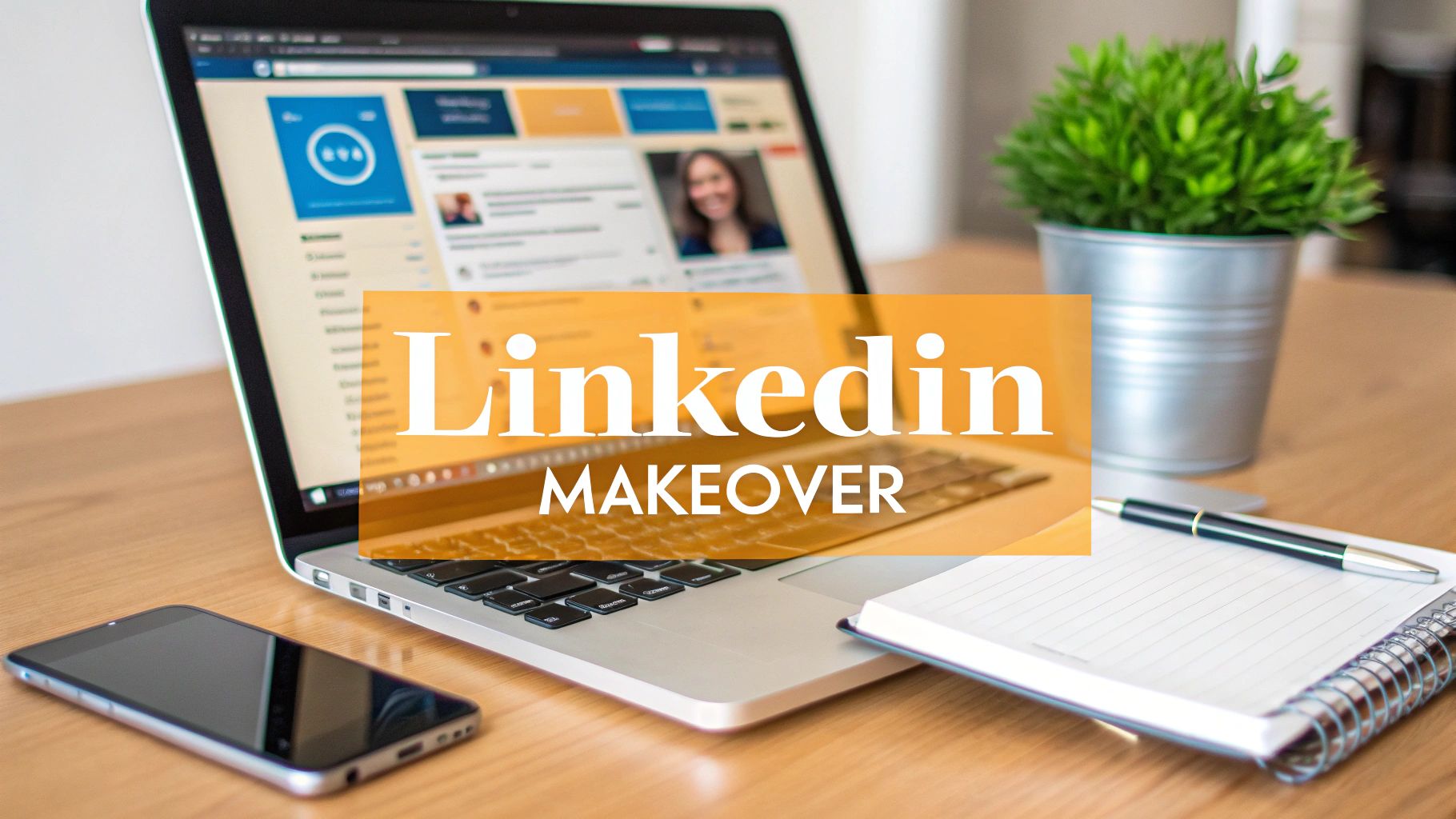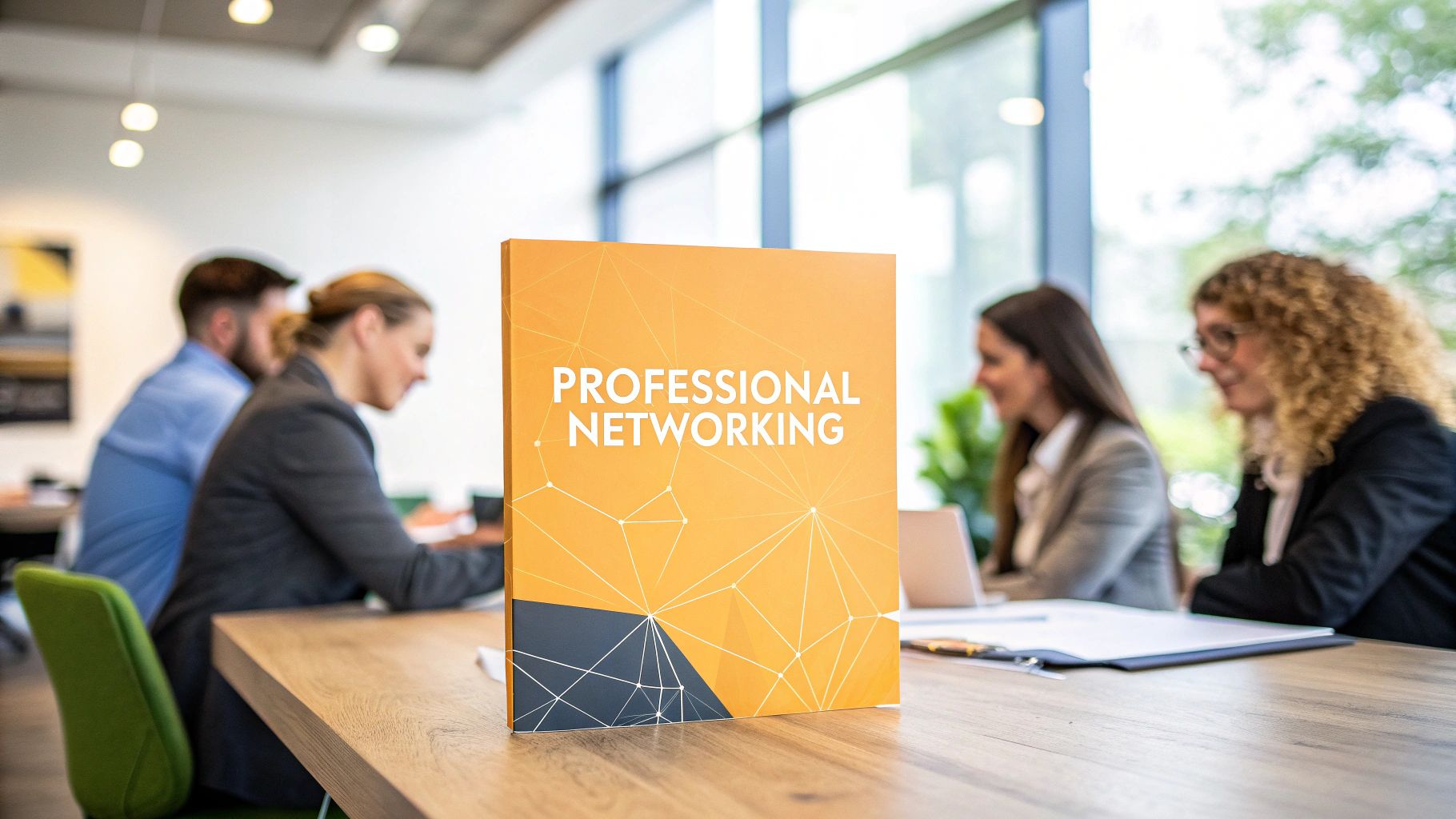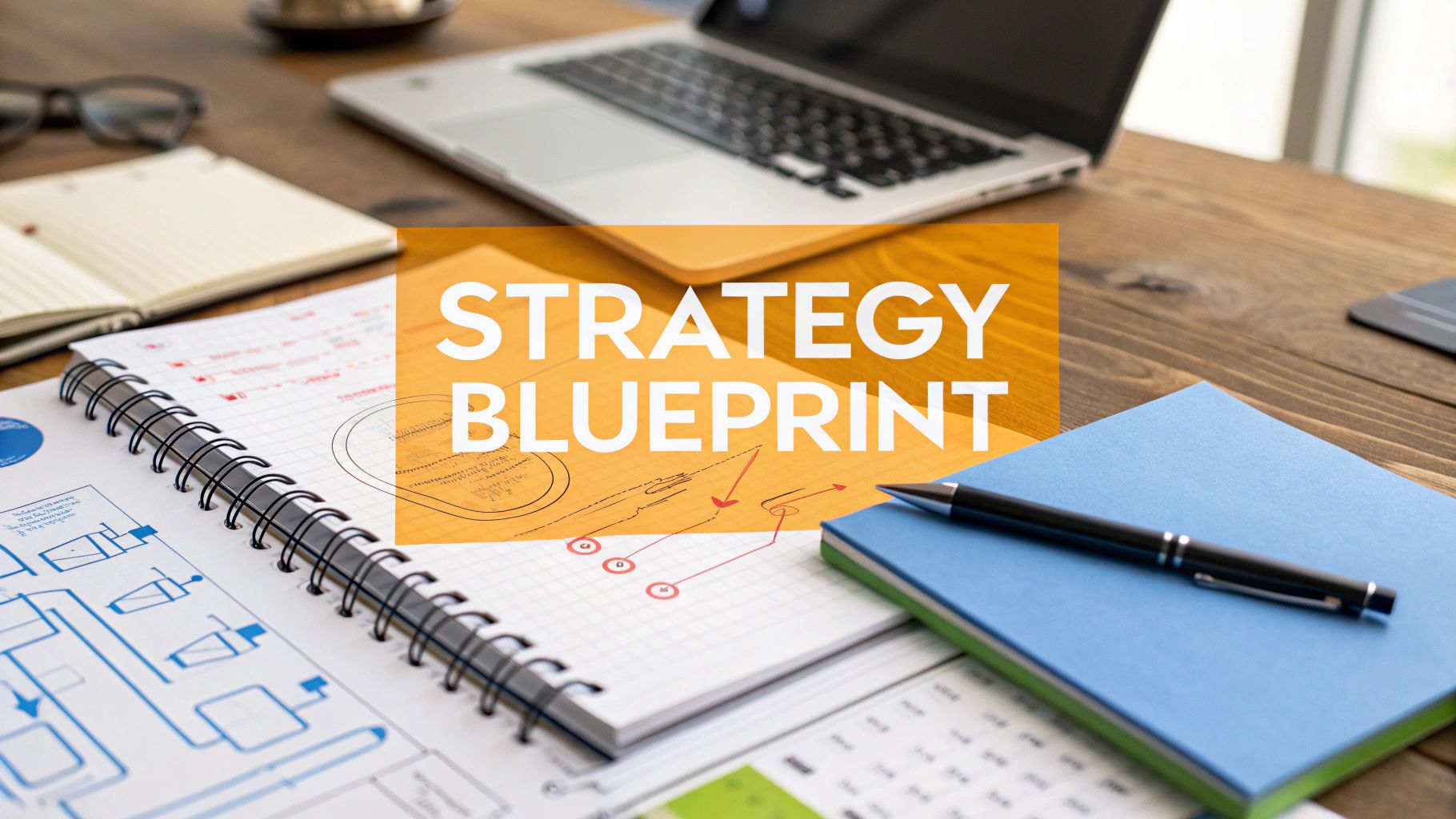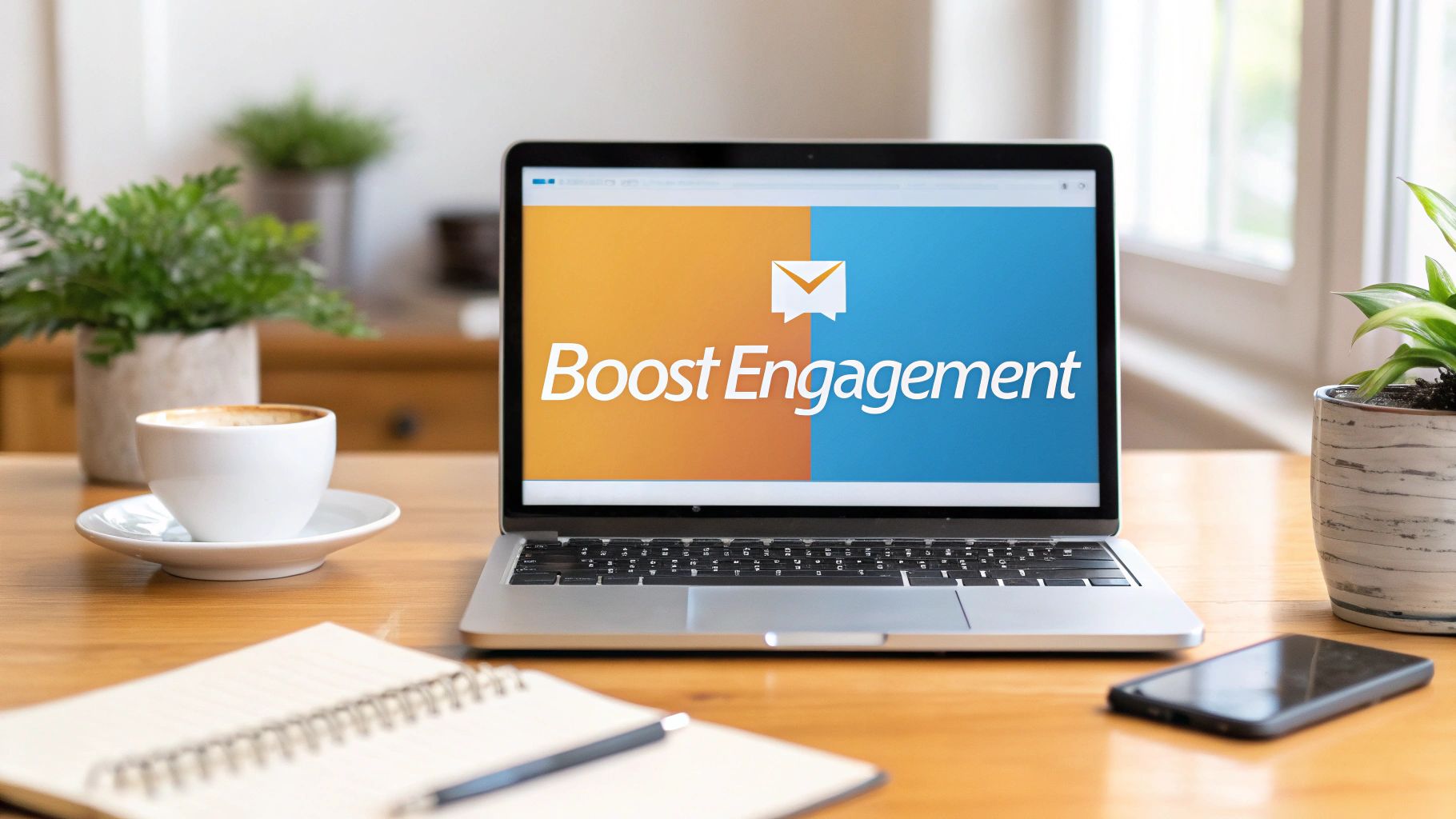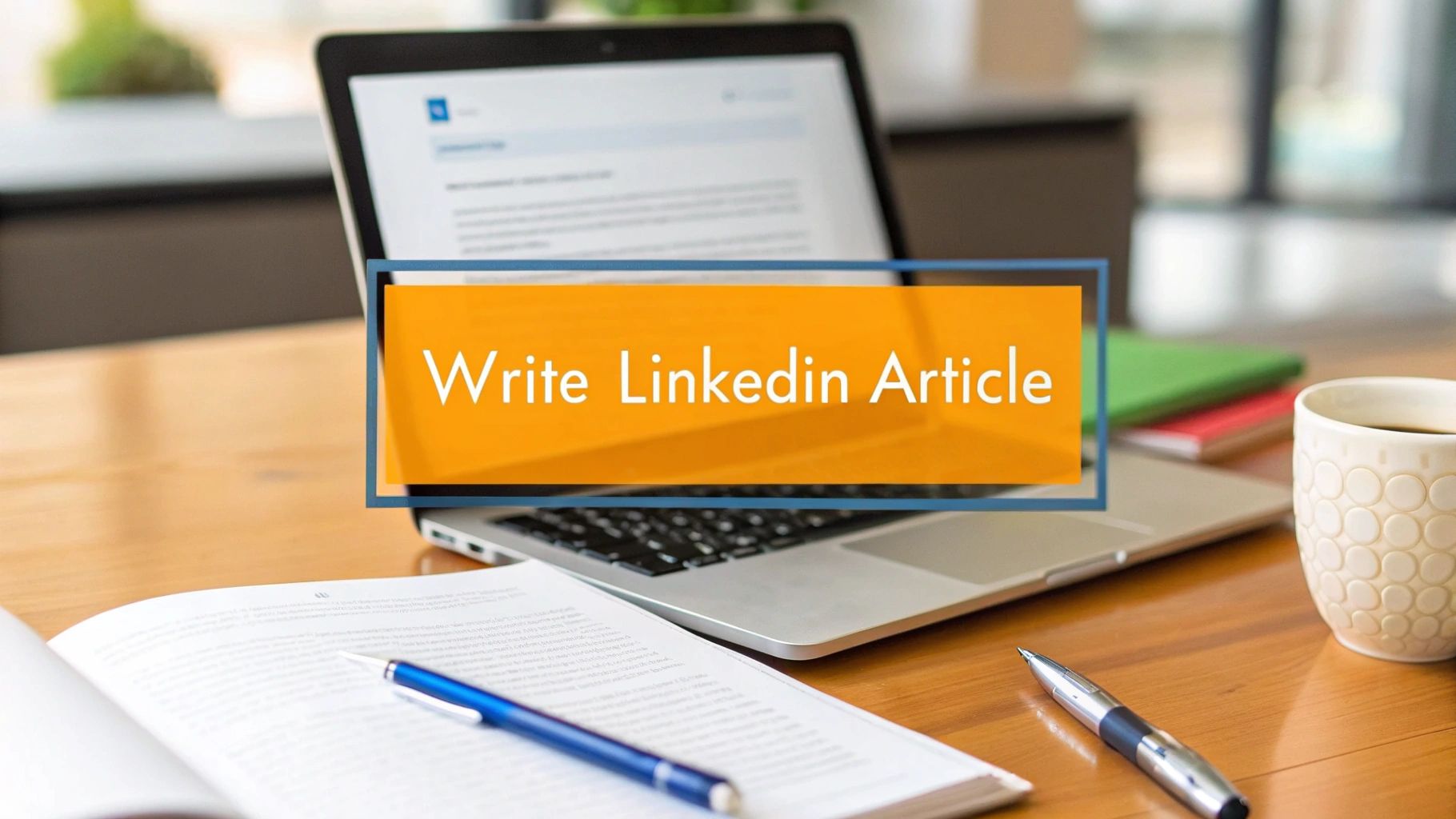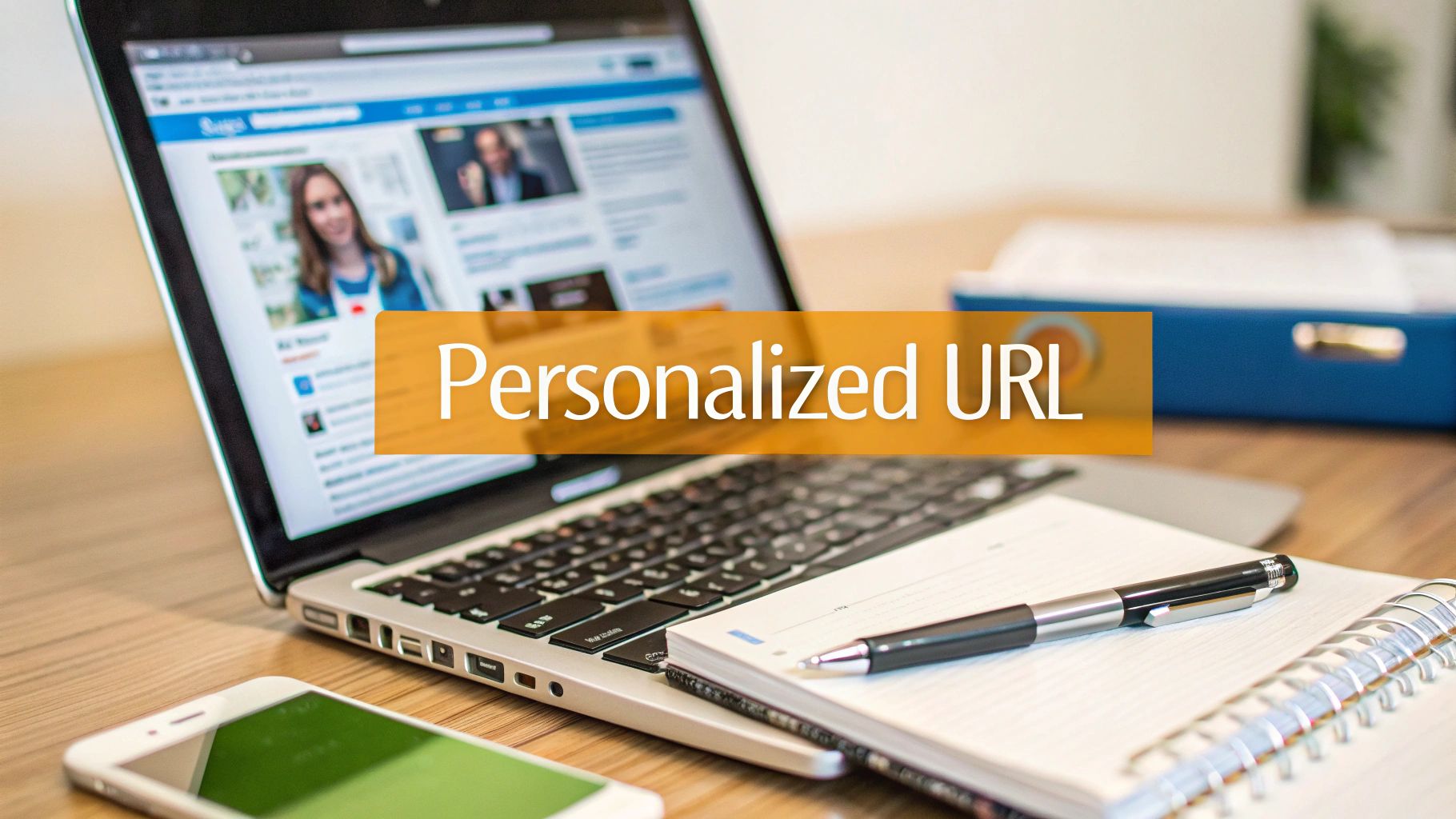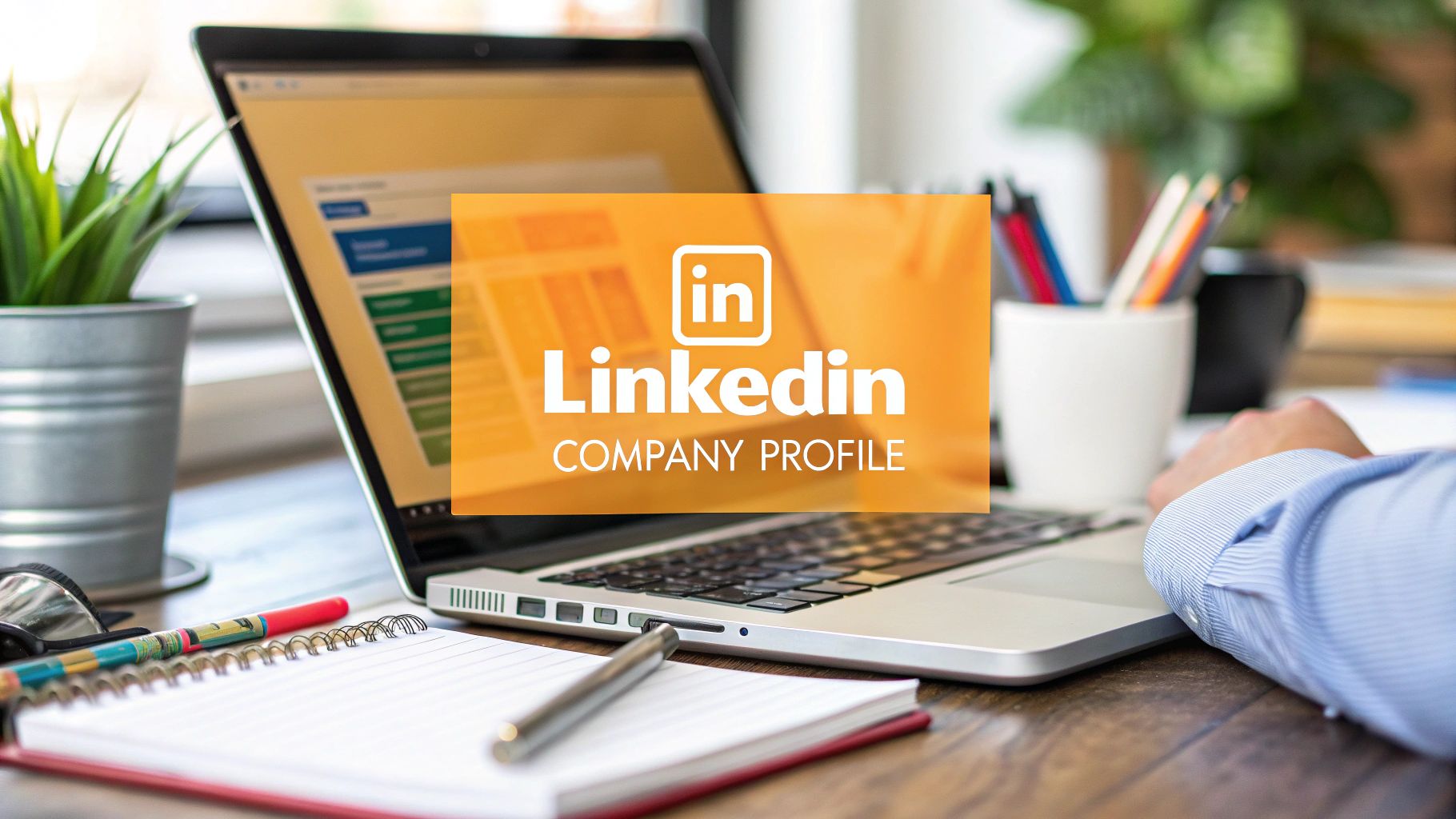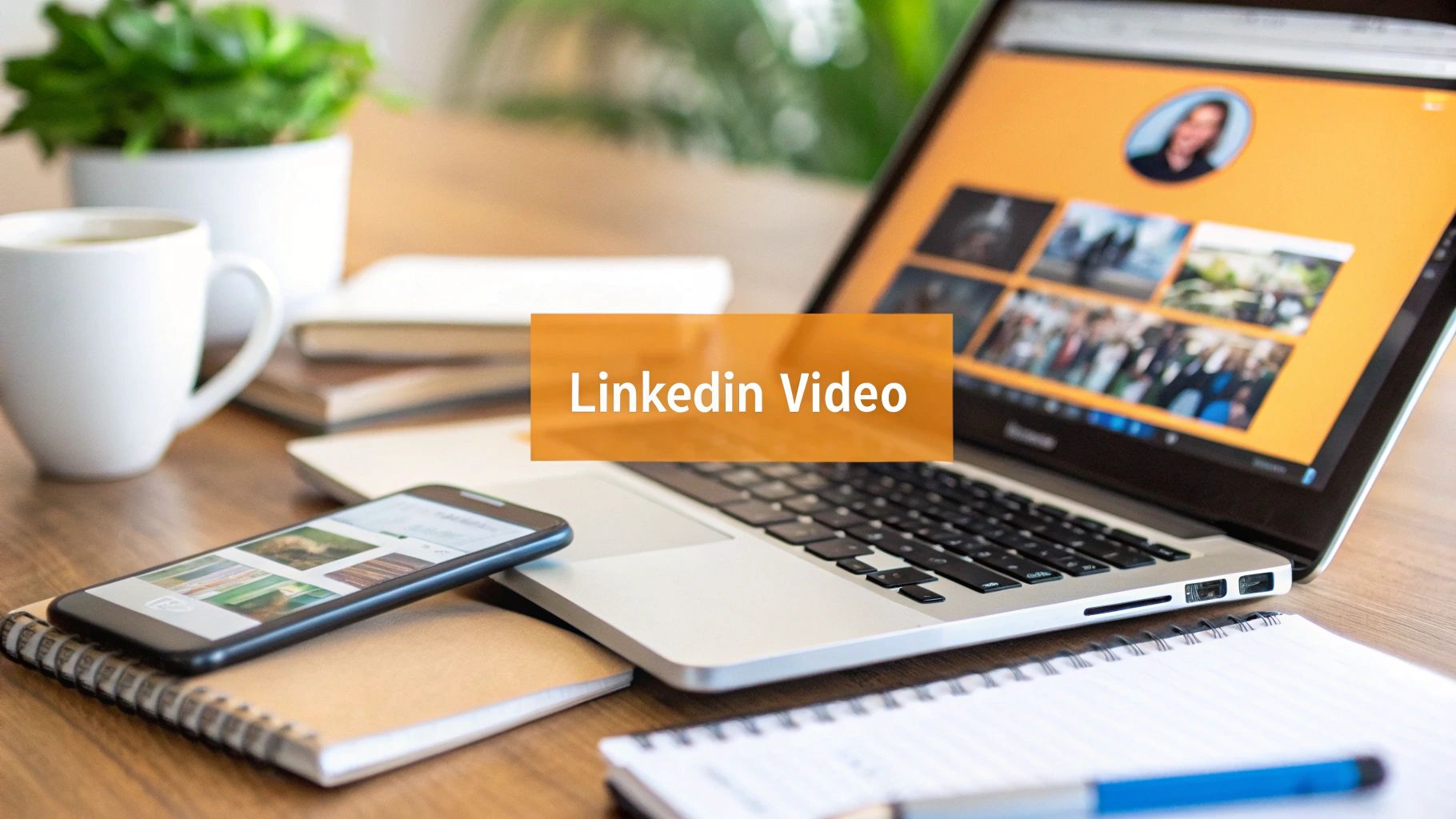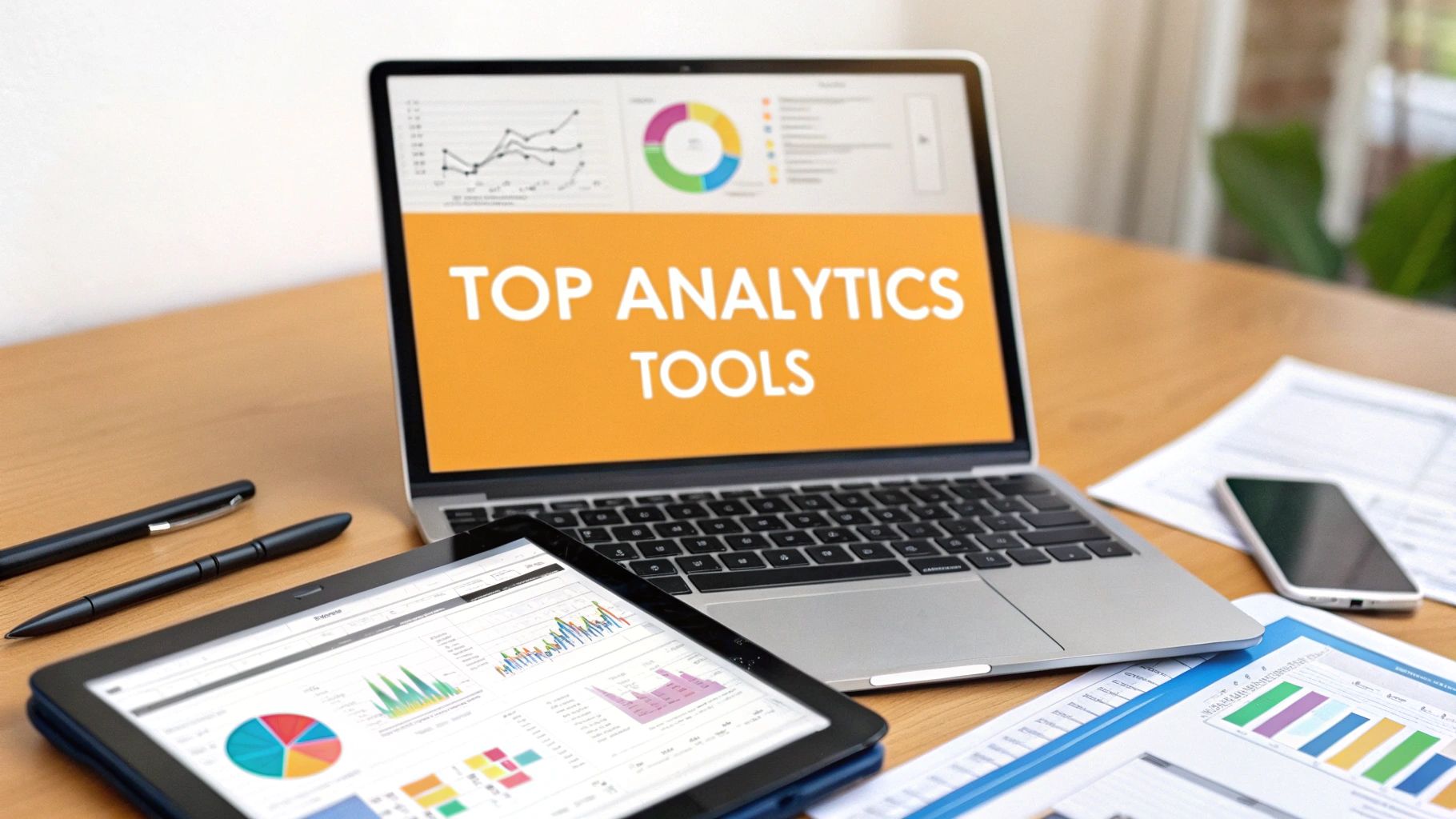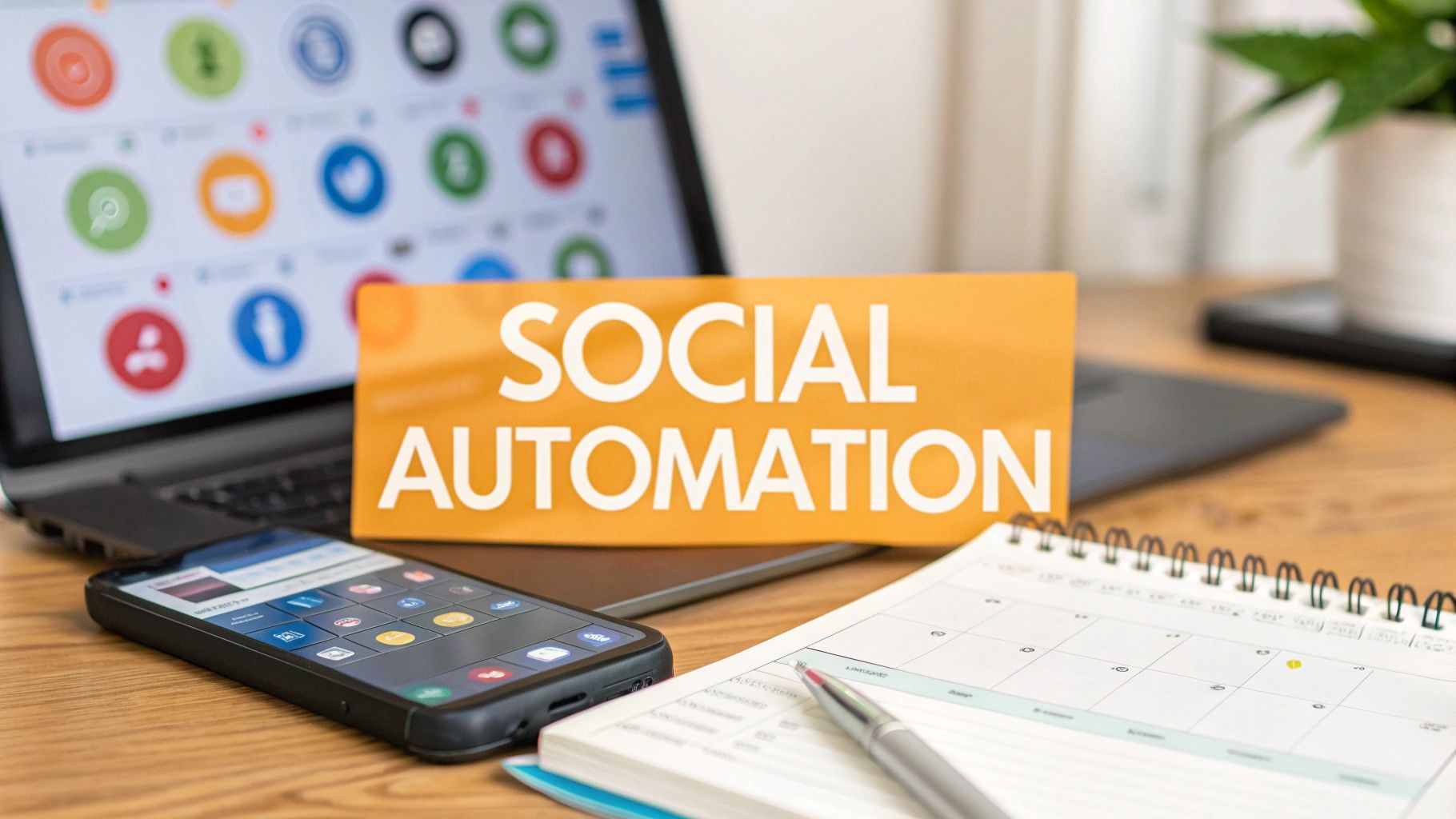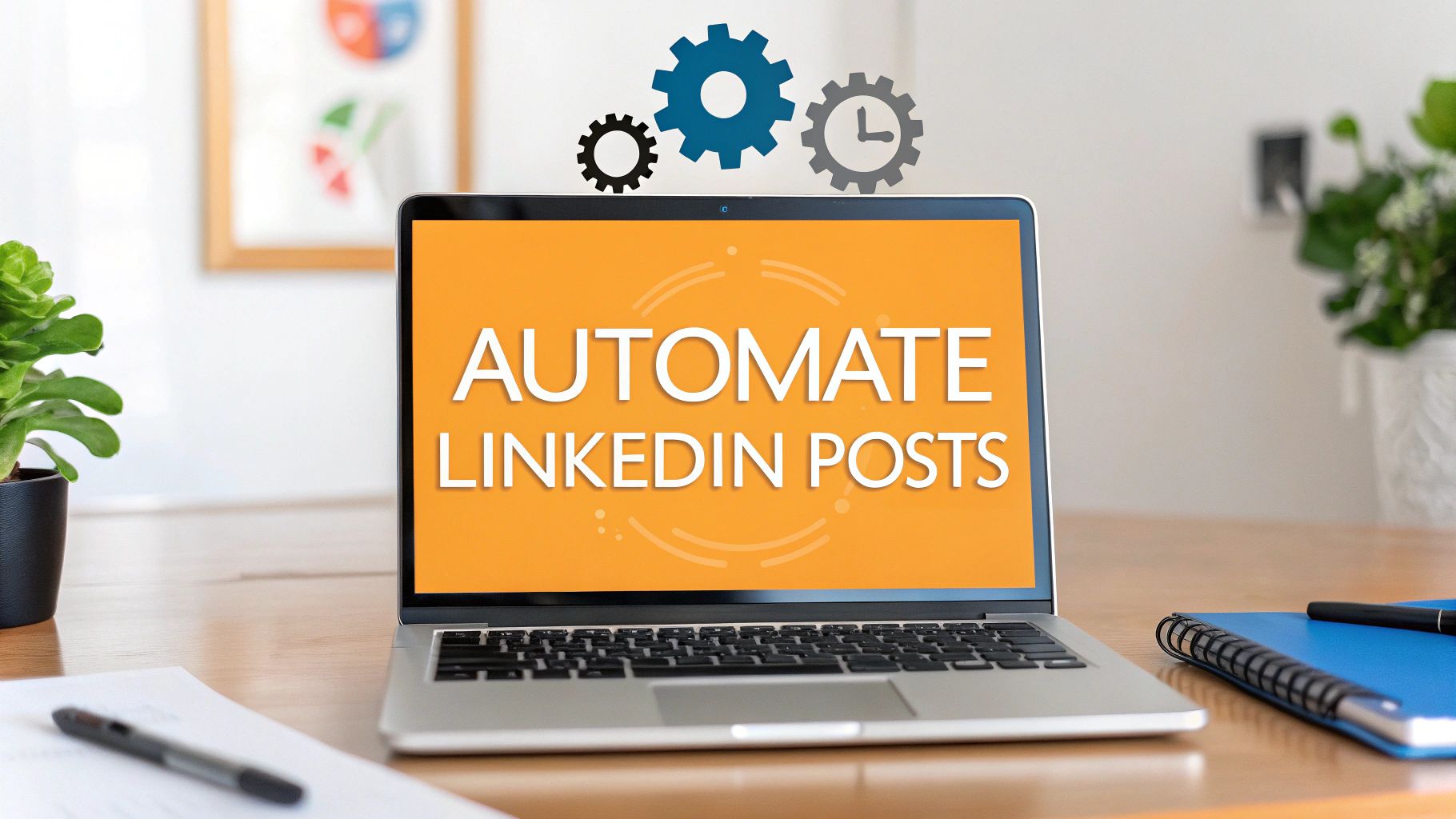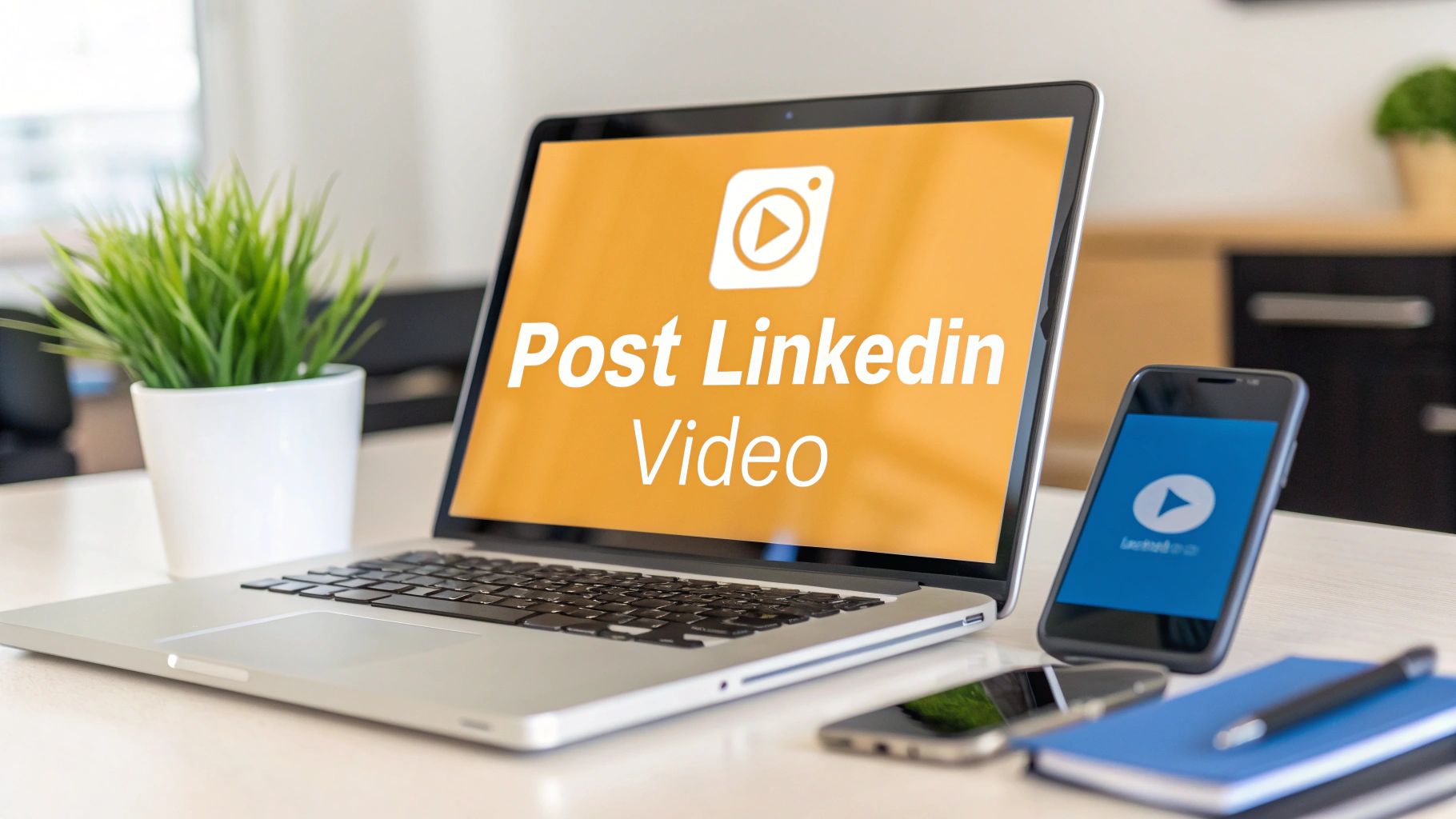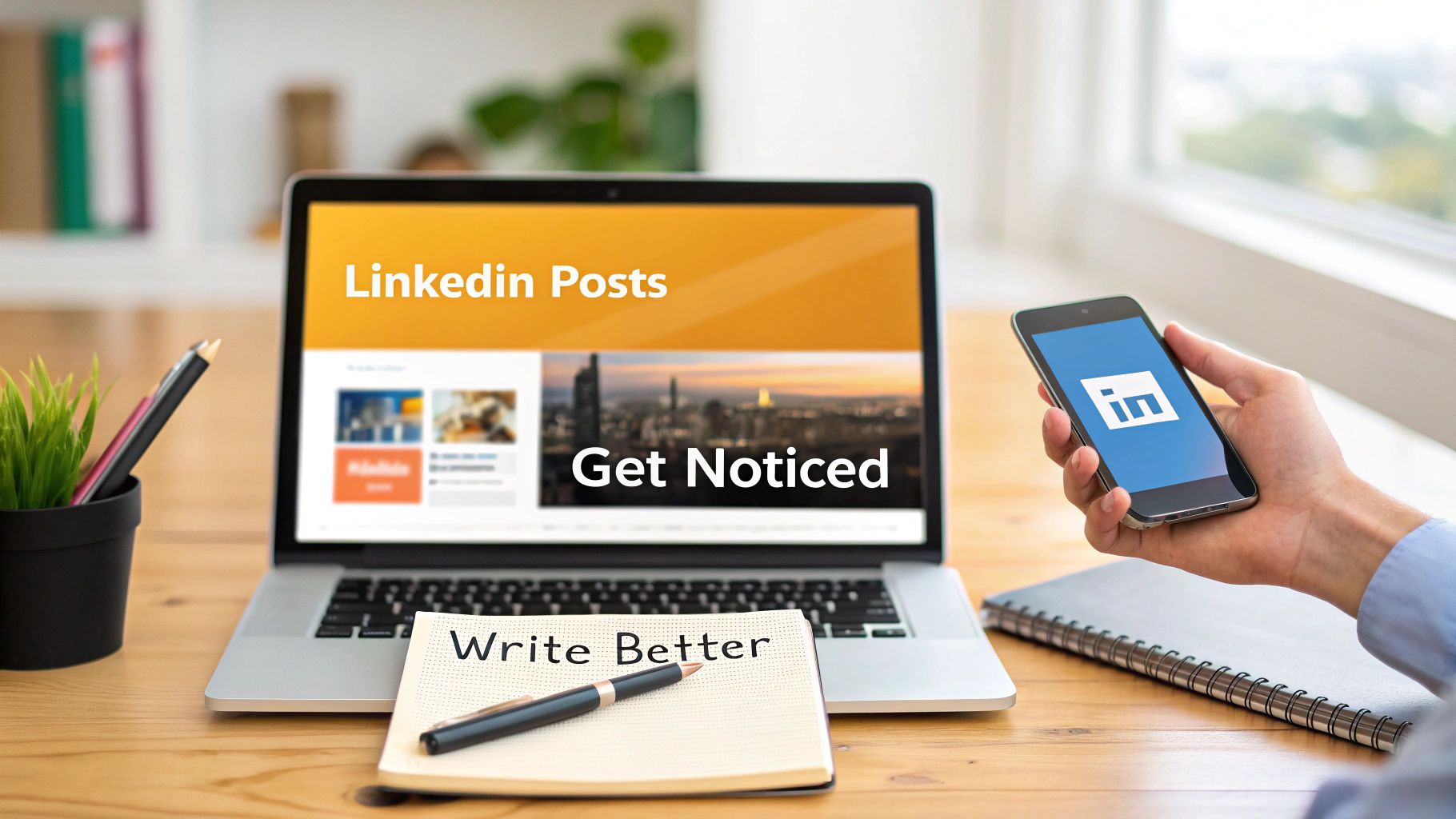Writing articles on LinkedIn isn't just about sharing a few thoughts—it's a serious strategic play to build your brand and cement your authority. Unlike a post that vanishes down the feed in a few hours, an article becomes a permanent fixture on your profile. It's your digital soapbox, a place to showcase what you really know, pull in exciting opportunities, and actually connect with the big players in your industry.
Why Writing on LinkedIn Is a Career Superpower

Let's get one thing straight: LinkedIn is not your dusty old online resume anymore. It's a living, breathing professional hub where the insights you share directly forge your reputation and can literally change the course of your career. While quick posts are fantastic for a daily high-five, writing LinkedIn articles is hands-down the best way to prove you’re a genuine thought leader.
Think about it this way: a post is like a quick chat in the hallway, but an article is your keynote speech. A post starts a conversation; an article makes a definitive statement. This is your chance to really dig into complex topics, share the lessons you’ve learned the hard way, and offer a point of view that a 300-word update just can’t handle.
Build Authority and Become a Go-To Expert
When you get into a rhythm of publishing genuinely helpful articles, something amazing happens. You stop being just another person with a job title. You become the one people seek out for answers. That shift is a game-changer. It elevates you from just another player in your industry to a voice that actually helps shape it.
And this authority isn't just about ego. It delivers tangible results. People are far more likely to trust, hire, and partner with professionals who consistently prove they know their stuff out in the open.
By sharing what you know in a structured, valuable way, you're not just creating content; you're building a digital asset that works for you 24/7, establishing credibility while you sleep.
Generate Opportunities Without the Hard Sell
Here’s where the magic really kicks in: attracting inbound leads and opportunities without ever feeling like a salesperson. A well-crafted article that solves a real-world problem for your ideal audience is like a magnet for potential clients, recruiters, and collaborators.
Instead of spamming inboxes with cold outreach, you're creating a world where your perfect connections find you. They arrive already impressed by your expertise and convinced of the value you bring. It completely flips the script on networking and business development.
The platform's incredible growth just pours fuel on this fire. LinkedIn rocketed to over 1.15 billion users by early 2025, a jump of nearly 80% in just six years. With an educated, professional audience signing up at a rate of 2-3 new members per second, your articles have a massive and ever-growing pool of high-value readers. You can discover more about LinkedIn's impressive user growth and see what it means for people creating content.
This explosion in users means your insights have the potential to land in front of a highly engaged audience hungry for professional knowledge.
Let's look at a quick summary of how this plays out in the real world.
The Real-World Impact of Publishing on LinkedIn
Consistently sharing your expertise through LinkedIn articles isn't just a vanity project; it leads to concrete professional gains.
| Benefit Area | Potential Outcome for Professionals |
|---|---|
| Professional Branding | You become synonymous with expertise in your niche, making you the first person people think of. |
| Networking & Connections | High-level professionals and decision-makers reach out to you for collaborations and discussions. |
| Career Advancement | Recruiters find you for unlisted, senior-level roles based on the depth of your knowledge. |
| Business Development | Inbound leads from ideal clients increase, shortening your sales cycle significantly. |
| Credibility & Trust | Your articles serve as social proof, making it easier to close deals or land speaking gigs. |
The takeaway is clear: the effort you put into writing directly translates into career and business momentum.
Differentiate Yourself in a Crowded Market
Let's face it, your job title is probably the same as thousands of other people's. But your experiences, your perspective, and your voice? That’s all you. Writing articles on LinkedIn is your stage to put that unique value on full display.
Here, you can tell stories, break down trends through your own lens, and even share opinions that challenge the way things have always been done. This is how you add color and personality to an otherwise black-and-white profile, making you memorable. And in a fiercely competitive professional world, being memorable is a massive advantage.
Finding Article Ideas That Actually Resonate

Let's be honest. The hardest part of writing LinkedIn articles isn't the writing. It's that awful, blinking cursor on a blank page while you desperately try to think of something—anything—to say.
A brilliant idea is the engine of any great article. Without a topic that genuinely connects, even the most polished writing will fall completely flat. Your goal isn't just to find any topic; it's to uncover something that showcases your unique expertise while scratching a real itch for your network. You want people to see your headline and have that "aha!" moment where they think, "I need to read this right now."
The best ideas are rarely found by staring at the ceiling. They're hiding in plain sight—tucked away in your daily work, your client conversations, and the problems you solve without even thinking about it.
Mine Your Daily Grind for Hidden Gems
Your day job is a content factory, whether you realize it or not. Every weird problem you solve, every project you complete, every new process you figure out… that's all potential article gold. These are the stories and lessons that only you can tell because you actually lived them.
Think about the last time you untangled a gnarly problem for a client. What was the situation? What were the exact steps you took? And what was the outcome? That whole story is an article just waiting to happen. This approach grounds your content in reality, making it infinitely more valuable than some abstract, theoretical piece.
To get the ball rolling, ask yourself a few questions:
- What are the same 3 questions my clients always ask? If one person is asking, you can bet a hundred others are silently wondering the same thing. Boom, instant article topic.
- What did I learn from a recent project that went sideways? Don't be afraid to share the mistakes. People connect with realness and learn way more from "here's what I did wrong" than "here's how perfect I am."
- What common industry 'best practice' do I totally disagree with? A well-reasoned, contrarian take can spark incredible conversation and position you as a true thought leader.
Suddenly, the question isn't "What should I write about?" but "Which of my experiences should I share first?"
Listen In on Industry Conversations
To make sure your ideas are timely and relevant, you have to know what your industry is buzzing about. This doesn't mean you should just regurgitate what everyone else is saying. Instead, you're looking for an opening to add your unique voice to an ongoing conversation.
A fantastic way to do this is by using LinkedIn itself as a research tool. Pop some keywords related to your field into the search bar, filter by "Posts," and see what's getting traction. Look for the content earning tons of likes, comments, and shares.
Pay close attention to the comment sections on popular posts. That's where the magic is. You'll find follow-up questions, passionate debates, and raw pain points that can inspire your next deep-dive article.
Use LinkedIn's search not just to find people, but to find conversations. The comments on a viral post are often more valuable for idea generation than the post itself.
Gut-Check Your Ideas Before You Write a Single Word
Before you sink hours into writing, take a few minutes to make sure your idea actually has legs. A quick validation process can save you from pouring your heart into a piece that no one is actually looking for.
This step is all about getting to know your audience on a deeper level. For a more comprehensive look at this, our guide on https://redactai.io/blog/how-to-identify-target-audience is a great place to start.
Here’s a quick-and-dirty validation checklist:
- Do a quick LinkedIn search. Are there a ton of articles on this already? If so, can you bring a fresh perspective, a more detailed guide, or a compelling counter-argument? If not, you might have found an untapped niche.
- Test the waters in a group. Pop your idea as a question into a relevant LinkedIn or Facebook group. Something like, "Hey everyone, I'm thinking of writing an article on [your topic]. What's your single biggest challenge with this?" The replies will not only confirm interest but also give you the exact language and pain points to include in your article.
- Analyze what's already working. Check out the most successful articles in your space. What do they have in common? Usually, they solve a very specific, nagging problem or offer a clear path to an aspirational goal.
This simple process creates a repeatable system for coming up with killer ideas. When you consistently tap into your own experience and check it against what your audience actually wants, you'll never be intimidated by that blank screen again.
How to Structure Your Article for Maximum Impact
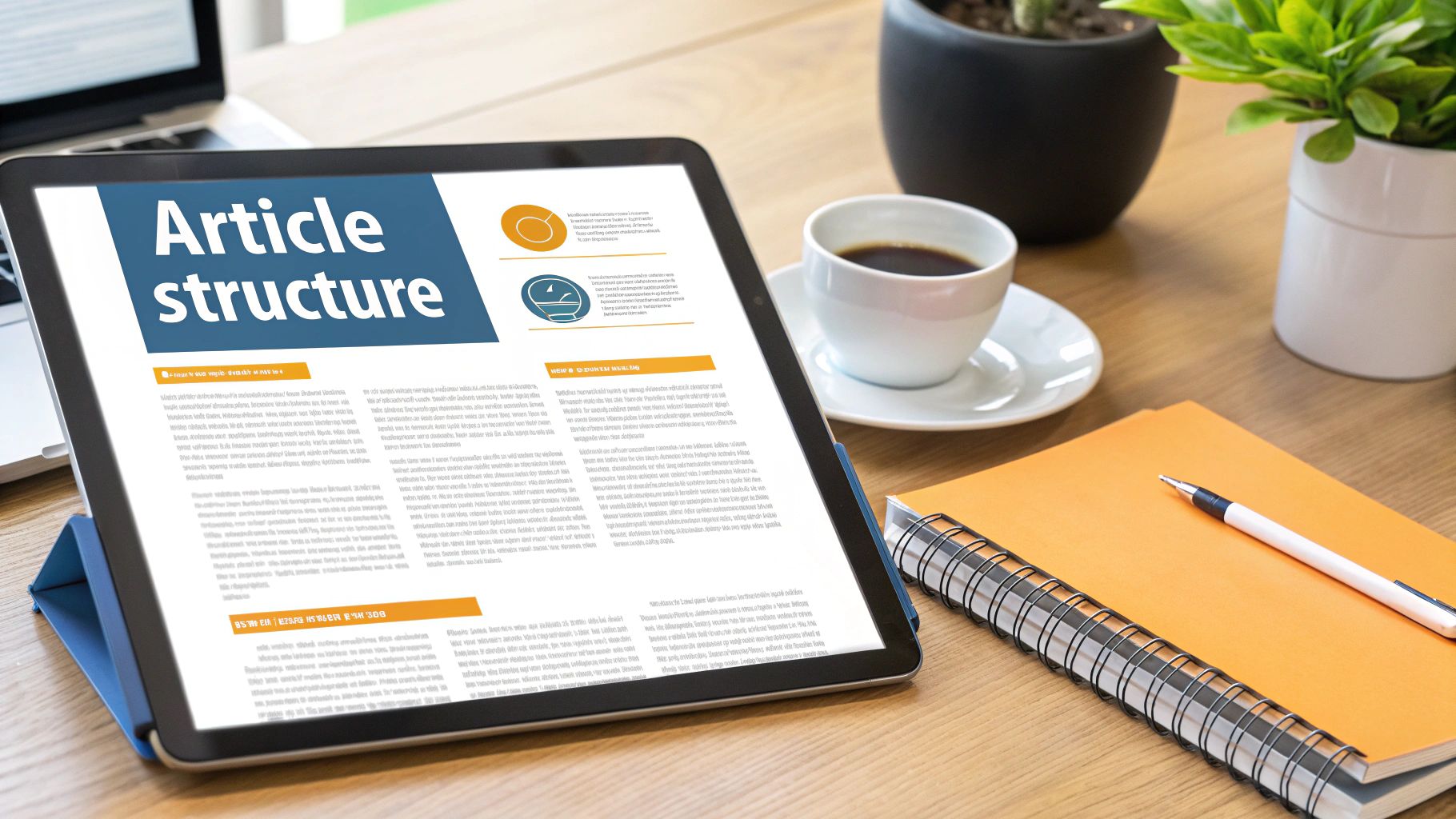
A brilliant idea can fall completely flat without a solid structure to hold it up. This is especially true on LinkedIn, where you’re competing for the attention of professionals scrolling between meetings. How you organize your thoughts is just as crucial as the thoughts themselves.
Think of it like building a house. You wouldn't just start throwing up walls, right? You need a blueprint. A great article structure is your blueprint—it guides the reader from a compelling start, through a few interesting points, to a conclusion that makes them glad they spent their time with you. Without that map, they'll get lost and bounce.
Craft a Magnetic Headline
Let's be real: your headline is everything. It's the one shot you get to stop the scroll. It’s not just a title; it's a tiny, powerful ad for the value you're about to deliver. A killer headline makes a specific promise and piques just enough curiosity to earn the click.
Vague titles are the kiss of death. "Tips for Better Management" is a snoozefest. But what about "5 Management Mistakes That Are Quietly Killing Your Team's Morale"? See the difference? The second one hits a nerve and promises a clear, valuable takeaway.
I've found a few headline formulas that almost always work:
- The List: "7 Unconventional Ways to Boost Your Productivity This Week"
- The How-To: "How to Write a Follow-Up Email That Actually Gets a Response"
- The Mistake: "The Biggest Mistake I Made Early in My Career (and How I Fixed It)"
Just remember to deliver on the promise. Clickbait might get you a view, but it destroys trust fast.
Hook Them Immediately with Your Introduction
Okay, they clicked. Now the clock is ticking. You have about three sentences to convince them to stick around. Your intro has to immediately answer their silent question: "What's in it for me?"
Forget the long, winding warm-ups. Dive right in. Kick things off with a relatable problem, a shocking statistic, or a bold claim that flips a common belief on its head. This is your signal that you're not here to waste their time.
A personal story is another great way to open. It creates an instant human connection and makes your expertise feel earned, not just stated. You’re trying to build momentum that pulls the reader right into the good stuff.
Your introduction is a contract with the reader. It promises to deliver specific value in exchange for their time. Fulfill that promise, and you'll earn a loyal follower.
Build a Scannable and Digestible Body
Nobody—and I mean nobody—wants to stare down a massive wall of text, especially on their phone. The body of your article needs to be broken into logical, bite-sized chunks. When you're writing LinkedIn articles, formatting is your secret weapon.
Use clear, descriptive subheadings to act as signposts. They let people scan your article and get the gist in seconds, which paradoxically makes them more likely to slow down and actually read it.
Inside each section, keep your paragraphs super short. I'm talking one to three sentences, max. This creates the white space our eyes crave on a screen. Then, layer in other formatting tricks to make key info pop:
- Bold text makes important terms or numbers impossible to miss.
- Bulleted lists are perfect for steps, tips, or examples. They're just so easy to read.
- Blockquotes are fantastic for highlighting a core insight or a powerful quote.
When you mix and match these elements, you create a visual flow that keeps people engaged and scrolling. It shows you respect their time and know how to communicate clearly—a massive part of building thought leadership. If you want to see this in action, check out these awesome thought leadership content examples. Nailing your structure is how you turn good ideas into content that positions you as an expert.
Finding Your Voice to Build Real Trust
Let's get one thing straight: forget the stiff, corporate-speak you think you need when writing LinkedIn articles. The stuff that actually works—the articles that get passed around and ignite real conversations—sounds like it came from a passionate, living, breathing person. Not a marketing bot.
Your authentic voice is your biggest advantage on this platform. It's the one thing that separates you from thousands of other people with the exact same job title. People don't connect with logos; they connect with other people. The goal here is to sound less like a press release and more like you're grabbing coffee with a colleague and sharing what you actually know.
This doesn't mean airing your dirty laundry or getting too casual. It's all about striking that perfect balance: professional, but undeniably personal. It’s about being confident enough to share your real opinions, tell stories from your own career, and write in a way that just feels like you.
Let Your Personality Shine Through (Professionally)
Finding your voice really begins when you give yourself permission to sound like yourself. If you're naturally energetic and upbeat, let that come through! If you're more of an analytical, data-first thinker, lean into that strength. Faking a persona is exhausting, and trust me, people can spot it a mile away.
Just imagine explaining a tricky concept to a smart friend over lunch. You'd probably use simpler language, maybe a good analogy, and you’d cut to the chase. That’s the exact conversational vibe you should be aiming for.
Here are a few simple tricks to get there:
- Talk directly to your reader: Use words like "you" and "your" to make it feel like a one-on-one chat.
- Pop in a few questions: Asking rhetorical questions pulls the reader into your train of thought and makes them feel like part of the conversation.
- Write in the first person: Using "I" and "we" is so much more powerful than a detached, third-person perspective. It's your experience, so own it!
This human-centric approach is especially critical in the B2B world. When you consider that 93% of B2B marketers rely on LinkedIn for their campaigns, the need for trust becomes crystal clear. With the platform now home to over 1 billion members, creating content that connects is no longer just a nice-to-have; it's the only way to stand out. You can dig into more of these LinkedIn statistics to see just how big the opportunity is.
Weave in Personal Stories to Make Your Points Land
Facts tell, but stories sell. On LinkedIn, they sell your expertise and your credibility. A quick personal story or a real-world example is hands-down the best way to illustrate a point and make it stick. It shows your advice isn't just theory—it was learned in the trenches.
So, instead of just saying, "Resilience is important," tell a short story about that one project that went completely off the rails and what you learned pulling it back from the brink. That story is far more engaging and teaches a much more valuable lesson.
Your experiences—both the wins and the epic fails—are your content goldmine. They add color and credibility, transforming you from just another expert into a relatable guide people want to follow.
Sharing these moments shows a bit of vulnerability and humanity, which are the building blocks of trust. When you're open about your own journey, you give others an invitation to connect with you on a much deeper level.
Share an Opinion and Start a Real Conversation
Playing it safe is the fastest way to be forgotten. The thought leaders we all admire aren't afraid to take a stand and share a well-reasoned opinion, even if it goes against the grain. This is what sparks the best discussions.
Now, this isn't about being controversial just for clicks. It’s about adding your unique perspective to an important industry conversation. Read an article you completely disagree with? Write a thoughtful response explaining why. Found a better way to solve a common headache in your field? Break down your method and show people how it works.
When you offer a clear point of view backed by experience, you invite people to engage. You stop being a passive observer and become a leader who's actively shaping your industry. That's how you turn readers into a real community.
A Smart Promotion Strategy for Your LinkedIn Article

So you’ve hit that big blue 'Publish' button. It’s a great feeling, but the work isn’t over yet. Honestly, the most crucial part is just getting started.
Writing a killer LinkedIn article is only half the battle. The other half is making sure people actually see it. A brilliant piece of content without a solid promotion plan is like shouting into the void—you’ve said something valuable, but nobody’s there to hear it.
Let's be real: just because you publish something on LinkedIn doesn't mean an audience will magically appear. You have to actively get your insights in front of the right eyeballs. It’s time to put on a marketer’s hat, just for a little while, and give your hard work the launch it deserves.
First, Nail the On-Page SEO Basics
Before you share your article anywhere, you need to make sure it’s set up for success right on the platform. LinkedIn’s search function is surprisingly powerful, and a few small tweaks can make a world of difference for discoverability.
Start by looking back at your headline and the first few sentences. Did you naturally weave in keywords your audience would actually search for? Don't keyword-stuff, but make sure the main topic is crystal clear from the get-go.
Then, scroll to the bottom and add a few relevant hashtags. Think of these as signposts for the algorithm. LinkedIn uses them to categorize your article and show it to people interested in those topics. I like to use a mix of broad and more specific tags.
- Broad: #Leadership, #Marketing, #PersonalBranding
- Niche: #ContentStrategy, #B2BLeadGen, #ExecutiveCoaching
This simple step helps LinkedIn figure out who your article is for, which is exactly what you want.
The Secret is in the Promotional Post
Here’s where so many people miss a huge opportunity. They just publish the article and call it a day. The real secret is to create a separate, compelling LinkedIn post that acts as a teaser or trailer for your article.
This post is your chance to sell the click. Don't just drop the link with a generic, "Check out my new article!" That’s boring.
Instead, pull out a juicy hook from your piece. It could be a shocking statistic, a controversial opinion, or a relatable story that you opened with.
For instance, if your article is about common leadership blunders, your promotional post could start with something like: "I once watched a manager completely demotivate their entire team with one 'harmless' comment. It's a mistake I see leaders make all the time..." Now that creates curiosity and hints at the value packed inside the full article.
Your promotional post isn’t just an announcement; it’s the first taste of your article’s value. Give them a compelling reason to stop scrolling and click to read the rest.
Tag, Engage, and Get the Ball Rolling
To give your promotional post that initial little nudge, tag a few people or companies you mentioned in the article. You can also tag people who you genuinely believe would find it valuable. The key here is relevance, not spam. Only tag people you have a real connection with who would appreciate the heads-up.
Once your post is live, your job switches to community manager. As the comments start to trickle in, respond to every single one. Don't just "like" them—ask follow-up questions and get a real conversation started. This activity sends a powerful signal to the LinkedIn algorithm that your content is sparking interesting discussions, which helps push it out to a wider audience.
Squeeze More Juice From Your Article by Repurposing
One of the smartest ways to maximize all that effort is to break your article down into smaller, bite-sized pieces of content. Not everyone has 10 minutes for a 1,500-word read, but they might have 30 seconds for a quick carousel or a short video. For a deeper dive, you can explore some proven content distribution strategies.
Here are a few quick ideas to get you started:
- Make a Carousel Post: Turn your article's main points or subheadings into a simple, visually engaging slide deck.
- Shoot a Quick Video: Hop on camera for 60 seconds and talk through the core idea of your article. It feels personal and grabs attention.
- Create Quote Graphics: Pull out the most powerful sentences or stats from your piece and pop them into a nicely designed graphic.
Visuals do incredibly well on LinkedIn. Data from early 2025 showed that multi-image posts get the highest average engagement rate at around 6.60%. This stat alone shows why blending your text-heavy article with more visual promotional content is a non-negotiable strategy for getting the most reach.
By repurposing your core ideas into different formats, you give your network multiple chances to discover your expertise. It’s how you make sure all that hard work pays off long after you’ve published.
A Few Common Questions I Hear About Writing on LinkedIn
Even with the best game plan, you're bound to run into a few specific questions once you really start digging into writing LinkedIn articles. Let's walk through some of the most common ones I see professionals grapple with.
Think of this as your go-to guide for those moments when you're wondering, "Am I actually doing this right?"
So, How Often Should I Be Publishing an Article?
Look, consistency is always going to win out over frequency. For most of us who are already juggling a dozen other things, aiming for one genuinely great, in-depth article per month is a fantastic—and more importantly, a realistic—goal. It's so much better than scrambling to push out four half-baked articles in the same amount of time.
Pour your effort into creating one solid piece of content that people will actually find useful. After you publish it, you can spend the rest of the month sharing it, talking about it, and slicing it up into smaller posts, videos, or whatever else you like. This approach builds your reputation as a thoughtful expert and helps you avoid that dreaded burnout.
What’s the Perfect Length for a LinkedIn Article?
There’s no magic number here, but I’ve found the sweet spot for a successful LinkedIn article usually lands somewhere between 1,000 and 2,000 words. That gives you enough space to really dig into a topic, back up your points with some real-world examples, and offer actual solutions without making your reader’s eyes glaze over.
The real trick is to deliver serious value without any filler.
Your article needs to be exactly as long as it takes to solve your reader's problem or explore the topic properly—and not a single word longer. Always put quality and clarity first.
At the end of the day, a punchy 800-word article that solves a real problem is way more powerful than a 2,500-word monster that just rambles on.
Is It Okay to Repurpose My Blog Posts on LinkedIn?
Yes, absolutely! But please, don't just copy and paste. That's a huge missed opportunity. You've got to tweak that content so it feels right for the LinkedIn crowd and the more conversational vibe of the platform.
Here’s how I like to handle it:
- Rework the intro. Start with a personal story or a hook that speaks directly to the professionals you're trying to reach. Ditch the formal blog opening.
- Switch up the examples. If your original post had broad examples, swap them out for scenarios that are super relevant to the industries or job titles you’re targeting on LinkedIn.
- Write a new conclusion. End with a question or a call-to-action that encourages people to jump into the comments right there on LinkedIn.
A little pro tip: always publish on your own blog first. Give it a week or so for Google to find and index the original piece. Then, post the adapted version on LinkedIn. This way, your own website gets the SEO juice, and you still get to tap into a whole new audience.
Should I Really Be Using Emojis and Casual Language?
This one really comes down to your personal brand and who you're talking to. But for most people, the answer is a careful "yes." LinkedIn is a professional network, for sure, but it’s still a social network. If you write like an academic journal, you're just going to sound distant and robotic.
A few well-placed emojis can add a little personality and break up big blocks of text, which is always a good thing. And writing in a conversational tone just makes your ideas easier to connect with. You want to sound like a knowledgeable person, not a textbook.
Of course, know your audience. A graphic designer can probably get away with a lot more than a corporate lawyer. The best rule? Write in a way that sounds like you, while still being respectful of the people you want to read it.
Ready to stop staring at a blank page and start creating LinkedIn content that builds your brand? RedactAI uses your own profile and expertise to generate post ideas and drafts in your unique voice. Join over 21,000 creators and craft high-impact posts in minutes. Start for free on redactai.io.

